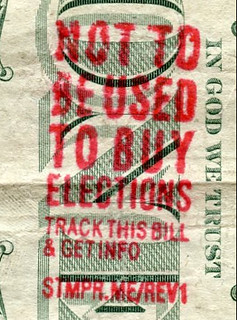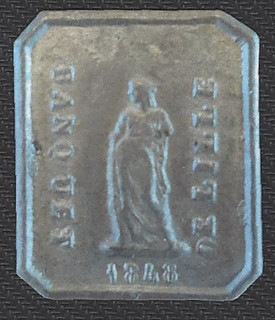
About UsThe Numismatic Bibliomania Society is a non-profit association devoted to the study and enjoyment of numismatic literature. For more information please see our web site at coinbooks.org SubscriptionsThose wishing to become new E-Sylum subscribers (or wishing to Unsubscribe) can go to the following web page link MembershipThere is a membership application available on the web site Membership Application To join, print the application and return it with your check to the address printed on the application. Print/Digital membership is $40 to addresses in the U.S., and $60 elsewhere. A digital-only membership is available for $25. For those without web access, write to: Terry White, Treasurer
AsylumFor Asylum mailing address changes and other membership questions, contact Terry at this email address: terrywhite5475@yahoo.com SubmissionsTo submit items for publication in The E-Sylum, write to the Editor at this address: whomren@gmail.com BUY THE BOOK BEFORE THE COINSale Calendar |
- WAYNE'S WORDS: THE E-SYLUM MARCH 20, 2019
- NBS GAINS TAX-EXEMPT STATUS
- HAMELBERG LIBRARY TOUR SURVEY
- BANKNOTE BOOK CUBA CHAPTER PUBLISHED
- BOOK REVIEW: 100 GREATEST ANCIENT COINS, 2ND ED.
- BOOK REVIEW: PRIMITIVE MONEY OF AFRICA
- KRAUSE PUBLICATIONS PARENT FILES FOR BANKRUPTCY
- DR. ROBERT CHANDLER
- COL. STEVEN K. WHITFIELD (1940-2019)
- NEWMAN PORTAL ADS BITLER LARGE CENT NOTEBOOKS
- QUERY: A.W. SHAW ENGRAVED COLUMBIAN HALF
- NOTES FROM E-SYLUM READERS: MARCH 11, 2019
- THE WILLIAM BARBER GRAVESITE
- DICK JOHNSON WELCOMES QUESTIONS FROM READERS
- VOCABULARY TERMS: TEST CUT, TEST MARK
- WILLIAM HARVEY STROBRIDGE (1822-1898)
- BEP BANKNOTE DESIGNER BRIAN THOMPSON
- 50-YEAR AMERICAN NUMISMATIC SOCIETY MEMBERS
- 1896 ARGENTUM UNIVERSALE ONE TALENT OFFERED
- SEDWICK MAY 2019 SALE HIGHLIGHTS
- THE CENTRAL BANK OF MONTENEGRO MONEY MUSEUM
- WAYNE'S NUMISMATIC DIARY: MARCH 17, 2019
- 1889 PENNY SAVED WWI SOLDIER'S LIFE
- APOLLO 11 HALF DOLLARS GO TO SPACE
- THE 2019 MEXICAN LIBERTAD SERIES
- 50TH JEWISH-AMERICAN HALL OF FAME MEDAL ISSUED
- JEWISH-AMERICAN HALL OF FAME MEDAL EXHIBIT
- DEATH OF A NORTHERN IRISH BANKNOTE
- HOW COLONIAL MASSACHUSETTS CREATED MONEY
- ALTERNATE CURRENCY TOTNES POUND DISCONTINUED
- PHILADELPHIA BANS CASHLESS STORES
- NEW JERSEY’S SAINT PATRICK COPPERS
Click here to access the complete archive
To comment or submit articles, reply to whomren@gmail.com
Content presented in The E-Sylum is not necessarily researched or independently fact-checked, and views expressed do not necessarily represent those of the Numismatic Bibliomania Society.
WAYNE'S WORDS: THE E-SYLUM MARCH 20, 2019
 This week we open with news
from NBS, one new book, two reviews, word of a bankruptcy affecting a major numismatic publisher, and the loss of two hobby figures.
This week we open with news
from NBS, one new book, two reviews, word of a bankruptcy affecting a major numismatic publisher, and the loss of two hobby figures.
Other topics this week include primitive money, William Barber, BEP engraver Brian Thompson, Sedwick sale highlights, a report from the Montenegro Money Museum, Apollo 11 half dollars, and St. Patrick coppers.
To learn more about Cuban banknotes, cowries, Dr. Robert Chandler, Col. Steven Whitfield, Worthington Bitler, Arch Shaw, Dick Johnson, test cuts, Atocha gold bars, Deserter Passes, Finnish art medals, the 2019 Mexican Libertad series, how Massachusetts created money, and the Ancient and Honorable Order of E Clampus Vitus, read on. Have a great week, everyone!
Wayne Homren
Editor, The E-Sylum
NBS GAINS TAX-EXEMPT STATUS
The E-Sylum is an electronic publication of the Numismatic Bibliomania Society. Here's an announcement of a recent change in our status. -Editor
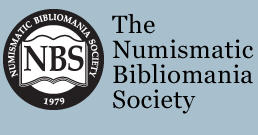 Good
Tax News for NBS Members! The NBS has been approved as a tax-exempt 501(c)(3) organization. Any donations beyond membership dues will now be tax deductible in
the U.S. We would like to thank Chuck Heck for his efforts in securing this vital status for the NBS and its membership.
Good
Tax News for NBS Members! The NBS has been approved as a tax-exempt 501(c)(3) organization. Any donations beyond membership dues will now be tax deductible in
the U.S. We would like to thank Chuck Heck for his efforts in securing this vital status for the NBS and its membership.
For more information on the Numismatic Bibliomania Society, see:
https://coinbooks.org/
HAMELBERG LIBRARY TOUR SURVEY
The Numismatic Bibliomania Society is in the early stages of planning a special event to be held during this summer's American Numismatic Association World's Fair of Money. NBS Vice President Len Augsburger submitted this announcement with a link to a survey for potential attendees. If you'll be attending the show and can spare a day for a memorable event, you're in for a great time with your fellow numismatic bibliophiles. -Editor
NBS Prepares to Invade Champaign: The Hamelberg Library Tour
Long time NBSers are no doubt familiar with the 1988 “Invasion of Louisville,” during which a busload of bibliophiles descended upon the Armand Champa residence for a day of fun and fellowship at the Champa library. For this year’s ANA, we are exploring the idea of a similar tour of the Dan Hamelberg library. An online survey has been created to gather feedback from potential visitors – which day would work best, travel arrangements, and so on.
The event would consist of a morning bus ride from Rosemont to Champaign, IL (about 2.5 hours), several hours of absorbing some of the finest numismatic literature in the world, feasting on local Champaign fare, and returning to Rosemont. Scheduling around the ANA is not trivial, and we do not expect consensus on the best time, but, in the interest of making this event accessible to as many as possible, we are gathering input at this early stage.
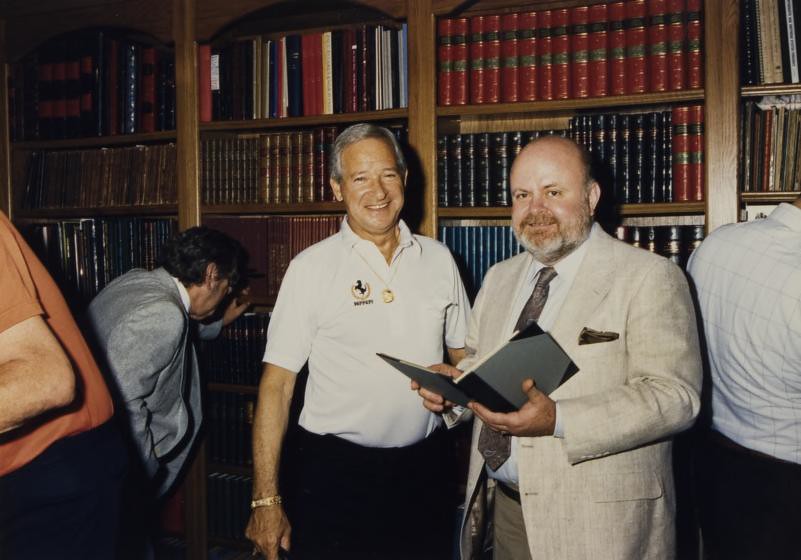
Armand Champa and George Kolbe at the 1988 “Invasion of Louisville”
Link to Hamelberg library visit survey:
Hamelberg Library Visit Survey (2019 Summer ANA Convention) (https://www.surveymonkey.com/r/R2BB7HN)
We held a similar, but smaller event when I was General Chairman of the 2004 Pittsburgh convention where we visited the Tom Fort and Wayne Homren libraries.
Opportunities like this don't come around every day. The Invasion of Louisville was a once-in-a-generation event that I'm eternally grateful to have been a part of. The Hamelberg visit promises to be equally memorable. As Len noted, finding an optimal time is a matter of choosing a least-worst option in relation to equally great events scheduled for the convention.
Thursday and Friday are off the table as those are the days of the regular NBS events. The ANA has not yet published the 2019 event schedule, but specialty clubs tend to have their meetings on the same days every year, and below is a link to the 2018 schedule. Your mileage may vary, so be sure to confirm dates with other organizations you belong to.
Space will be limited since we will have to consider the capacities of the shuttle bus and Dan's library spaces. -Editor
To view the 2018 World's Fair of Money schedule, see:
https://www.money.org/uploads/wfm18/0727%20Schedule
%20at%20a%20Glance%20ANA%202018.pdf

BANKNOTE BOOK CUBA CHAPTER PUBLISHED
Owen Linzmayer publishes The Banknote Book, a useful, constantly updated electronic reference. On March 15, 2019 he announced via email the availability of the chapter on the banknotes of Cuba. -Editor
 We're pleased
to announce that the Cuba chapter is now available for individual sale and as a free download to subscribers.
We're pleased
to announce that the Cuba chapter is now available for individual sale and as a free download to subscribers.
Cuba (Caribbean)
This 66-page catalog covers notes issued by El Banco Español de la Habana (The Spanish Bank of Havana) from 1857 to 1892, El Tesoro de la Isla de Cuba
(Treasury of the Island of Cuba) in 1891, El Banco Español de la Isla de Cuba (Spanish Bank of the Island of Cuba) from 1896 to 1897, Republica de Cuba
(Republic of Cuba) from 1934 to 1949, La Republica de Cuba (The Republic of Cuba) in 1869, Junta Central Republicana (Republican Central Committee) from 1869
to 1872, Banco Nacional de Cuba (National Bank of Cuba) from 1949 to 1995, and Banco Central de Cuba (Central Bank of Cuba) from 1997 to present. Revised
15.03.2019.
Currently 276 chapters of The Banknote Book have been published as individual high-resolution PDF files. This represents a total of 5,441 pages covering 50,509 types and varieties.
For more information, or to order, see:
The Banknote Book: Cuba
(https://banknotebook.contentshelf.com/shop#!cs/store=
S12121100000000A&action=product&product=I130621000001A4D)
BOOK REVIEW: 100 GREATEST ANCIENT COINS, 2ND ED.
Dennis Tucker of Whitman Publications writes:
The second edition of 100 Greatest Ancient Coins, by Harlan J. Berk, debuts in March 2019, two weeks before the American Numismatic Association’s National Money Show. Here, distinguished European numismatist Italo Vecchi, an award-winning scholarly author himself, reflects on Harlan Berk and the importance of 100 Greatest Ancient Coins.
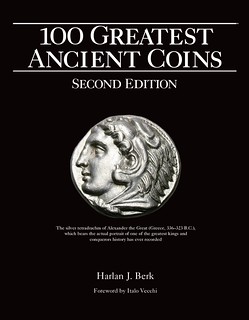 The first edition
of 100 Greatest Ancient Coins, by Harlan J. Berk (Whitman, 2008), was an instant success. This second edition again highlights Harlan’s personal choice
of 100 princely coins of unusual historical interest and beauty from the Late Archaic period to Late Antiquity. Each coin is described according to artistic
merit, historical context, and metrology. This edition presents, in an easily accessible format, Harlan’s scholarly and oft-cited study “The Coinage of
Croesus,” a clearly numbered catalog of all gold and silver coinage of that ruler, which makes this book invaluable for all serious ancient numismatic
academics, historians, dealers, and amateurs alike.
The first edition
of 100 Greatest Ancient Coins, by Harlan J. Berk (Whitman, 2008), was an instant success. This second edition again highlights Harlan’s personal choice
of 100 princely coins of unusual historical interest and beauty from the Late Archaic period to Late Antiquity. Each coin is described according to artistic
merit, historical context, and metrology. This edition presents, in an easily accessible format, Harlan’s scholarly and oft-cited study “The Coinage of
Croesus,” a clearly numbered catalog of all gold and silver coinage of that ruler, which makes this book invaluable for all serious ancient numismatic
academics, historians, dealers, and amateurs alike.
This is not just a simple reprint of the earlier version. Harlan’s selections have been modified and his descriptions and images improved, and he has added a useful summary of ancient gold and silver denominations.
Harlan Berk is an internationally renowned coin dealer and art collector whose profound scholarly knowledge applies not only to ancient numismatics, but to early archaeology, Dutch master paintings, the twentieth-century Chicago school of painting, and more, as befits a modern Renaissance man. He follows in the tradition of the early collectors of the Greek, Roman, and Byzantine coins that have fascinated erudite men and women since ancient times. As Suetonius reported of Augustus: “At Saturnalia, or at any other time when the fancy took him, he distributes to his company clothes, gold, and silver; sometimes coins of all sorts, even of the ancient kings of Rome and of foreign nations” (De vita Caesarum 75). Theodora, sister-in-law of Constantine IX, is reputed by Michael Psellus to have “gloated over her collection of darics, for which she had bronze coffers made” (Chronographia 6.63).
The fourteenth-century Italian humanist, scholar, and poet Francesco Petrarca, whose discovery of Cicero’s letters is often credited with initiating the Renaissance, is also recorded as one of the first known collectors of ancient coins. Other early collectors included Pope Boniface VIII and the emperor Maximilian I. Coin collecting became fashionable among the literati and members of the aristocracy—especially kings and queens—during the Renaissance and was called the “Hobby of Kings.” The first known book dedicated exclusively to ancient coins was published in Paris in 1514 by Guillaume Budé: De asse et partibus e jus, the source of which was probably the author’s own collection of Greek and Roman coins.
Harlan Berk’s corpus of 100 remarkable ancient coins is the latest in a long line to hold up a mirror to our nature, allowing us to see ourselves as we were in the classical civilizations of Greece and Rome—cultures much like our own but still tied to slavery and the land, more primitive and casually cruel, yet in outward show and art far more beautiful and, for many periods, inwardly happier and more content (though always threatened, like us, by rising tides of barbarism and internal strife).
As a native of Chicago, Harlan will be daily aware of the contrast between opulence and poverty, splendor and misery, that characterise any new Athens, Rome, or Constantinople, yet he has not allowed his friendly and hospitable disposition to be corrupted by pessimism. His wife, Pam Berk, like the amiable spouse of many a devoted numismatist and collector, has long tolerated with patience her husband’s obsession, which has made this remarkable catalog of 100 exceptional coins possible.
# # #
100 Greatest Ancient Coins, 2nd edition
By Harlan J. Berk; foreword by Italo Vecchi
ISBN 0794846327
Hardcover, 10 x 12 inches (coffee-table)
144 pages, full color
Retail $29.95 U.S
Dennis Tucker of Whitman Publishing adds:
We’re excited about the second edition of Harlan’s book. He’s told me of many collectors who have been inspired to get into ancient coins by reading it. What more can an author (or publisher) ask?
Books can change the world in ways small and large. In this case it's not like there weren't already a lot of people collecting ancient coins, but introducing the topic to a new audience expands the market and helps keep the tradition alive. And course, it means a LOT to the individual reader - it can sometimes be a life-changing event, opening up a whole new world to them. We need authors and publishers more than ever to organize and present all aspects of numismatics to ever-widening audiences. -Editor
To read the earlier E-Sylum article, see:
NEW BOOK: 100 GREATEST ANCIENT COINS, 2ND EDITION
(https://www.coinbooks.org/v22/esylum_v22n09a06.html)
BOOK REVIEW: PRIMITIVE MONEY OF AFRICA
John and Nancy Wilson submitted this review of a new book by James Zylstra on the primitive money of Africa. Thanks! -Editor
Author James Zylstra, Foreword by Robert D. Leonard Jr., 2018,
Reviewed by John and Nancy Wilson
 Primitive Money of Africa: Tales & Details by author James Zylstra is a soft bound 215-page reference
which has hundreds of color illustrations. It isn’t a price list of African primitive money but is a useful resource for the dealer or collector of these
artifacts.
Primitive Money of Africa: Tales & Details by author James Zylstra is a soft bound 215-page reference
which has hundreds of color illustrations. It isn’t a price list of African primitive money but is a useful resource for the dealer or collector of these
artifacts.
In the foreword Robert D Leonard Jr. commented Zylstra considers the dual nature of much African primitive money – as ornament and valuable – and the difficulties encountered in actual use, because of the different types demanded in each local market. He suggests that primitive money persisted as long as it did because modern currency lacked religious and traditional value, and potentially spoiled the enjoyment of vigorous bargaining.”
Mr. Zylstra won the 2019 Florida United Numismatists Best-in-Show award with his exhibit titled Primitive Money from the Democratic Republic of Congo.
In the introduction he discusses metal coins from the seventh century BC along with other types of money right up to his examination of primitive money in the African context. The author lived and worked in Africa in the 1970s and gained a vast knowledge of how money was used in government offices, banks and market places. This first-hand knowledge along with his study of primitive money from books made it possible to write this book.
The book is an easy read and explains some of the native reasoning for some of the primitive money. The author defines money and functions of money as he portrays it in this book. The four primary functions are, 1. medium of exchange. 2. store of value. 3. standard of value. 4. symbol of wealth.
The book of the Henry M. Stanley and his expedition in 1871 to search for the missionary explorer David Livingstone covers the many forms of money it used. The author says that most primitive money in Africa was used in the marketplace. He discusses the market day and the trials and tribulations of a shopper and what they went through to make purchases. The cost of a laying hen in the early 1900s may have been 650 cowries which would equal 14 cents in American money.
The author describes an African marriage he attended in 1976. He explains bride-price and how the value of the marriage was negotiated between the families. He mentions that domestic slaves were a commodity and were the second most important primitive money after iron.
The author discusses the value of salt which goes back eight thousand years. Slavery existed before the time of written history and slavery still exists in Mauritania, with 150,000 slaves out of a population of 3.8 million.
Primitive money can be items for farming, hunting, status symbols, bracelets, body decorations. Beauty, balance and grace are evident in many of the money items.
Tribal leaders utilized many sources to show their status with not only villagers they controlled but other tribes they encountered. How they dressed and the adornments they wore along with other contributing factors such as the size of how many villagers they controlled, location of village, size of army, wealth they possessed & displayed and lastly the royal courts they ruled.
One of the most popular primitive money was cowries. It took 4000 cowries to equal one shilling. Without slaves it was impossible to transport cowries as their weight was greater than their value. This helped bring the demise of primitive money in Africa.
In 1949 the manilla was no longer legal tender in West Africa.
Near the end of the book you will find 65 primitive money items with pictures of them and a description and area it was used. Citations give the author and page of their book.
The book retails for $22.00. It can be purchased from Amazon.com under the author’s last name. Many other numismatic book dealers also carry the book. Mr. Zylstra will also be attending coin shows in Schaumburg, Michigan and Florida where he will have books for sale.
For more information, or to purchase, see:
Primitive Money of Africa: Tales and Details
(https://www.amazon.com/Primitive-Money-Africa-Tales-Details/dp/0578440113/ref=sr_1_fkmr0_1)
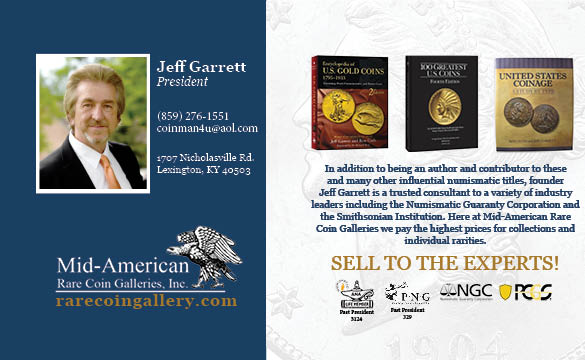
KRAUSE PUBLICATIONS PARENT FILES FOR BANKRUPTCY
By now most have heard about the bankruptcy of F+W Publications, publisher of Numismatic News, World Coin News, Bank Note Reporter, Coins magazine and the Krause standard catalogs. Here's an excerpt from a March 14, 2019 article from eCommerceBytes. -Editor
Instead of helping, ecommerce may have exacerbated the financial problems of a publisher of popular niche magazines and books that appeal to collectors, crafters, and other enthusiasts. Niche publisher F+W Media filed for Chapter 11 over the weekend after facing financial struggles for years.
The publisher had turned to ecommerce as a possible savior. But the New York Post reported, “The spectacular flop may serve as a cautionary tale to hard-pressed publishers who try to venture into e-commerce as a way to offset slumping print advertising circulation and revenue.”
Craft industry publication Craft Industry Alliance summed it up as follows: “A combination of declining subscriptions and ad revenue, plus a misguided effort to shift into ecommerce, led to a whole lot of debt.”
Many F+W magazines may be recognizable to EcommerceBytes readers. Collectibles titles include Antique Trader, Bank Note Reporter, Coins, Goldmine, Military Trader, Military Vehicles, Numismatic News, World Coin News, and Sports Collector Digest.
It also publishes books, calling itself the leading publisher of illustrated non-fiction books in art instruction, crafts, writing, genealogy, antiques and collectibles, woodworking, and the outdoors. “F+W is a major book publisher, producing and marketing hundreds of new book titles annually, and has a backlist of some 2,000 titles.
Last year, publishing trade publication Folio reported on a house-cleaning effort in January 2018 when the company’s board dismissed its CEO, COO, and CTO in one fell swoop.
It will be interesting to see what becomes of the company and its assets now.
Interesting indeed. The Comments section is worth reading, with a screed about the former short-term CEO who "made fun of the staff at industry events where he spoke. If he was challenged by anyone on staff he would reply “I built the NY Times website, I know what I’m doing.” I guess we know that that turned out.
Bankruptcy rids the company of its debt. I fear that could include its obligations pay pensions and other benefits to current and former employees. But none of this means the publications can't survive, or even thrive under new owners with a more realistic business model and guidance from people who actually understand the niche areas the publications cover. But that won't be easy at this point, and the numismatic publications could be merged away or shut down completely if new owners can't be found. For the time being at least, the company plans to remain in operation while it liquidates its holdings. -Editor
To read the complete article, see:
Ecommerce Could Not Save Niche Magazine Publisher
(https://www.ecommercebytes.com/2019/03/14/ecommerce-could-not-save-niche-magazine-publisher/)
To read Coin World's coverage, see:
Hobby publisher F + W Media files for
bankruptcy (https://www.coinworld.com/news/us-coins/2019/03/numismatic-news-owner-files-for-chapter-11-bankruptcy.html)
Howard Daniel writes:
I remember that first year F+W owned Krause Publications and most of it started going downhill. I was often driving up to Iola and contributing to them and living in one of the guest houses. Everything was going well but once the “ivory tower” took over, things here and there started to fail without explanation. It is really a sad situation.
Here's a link to the bankruptcy filing; it has several links to other information including the full list of creditors and the claims agent. A sad end for a century-old firm. -Editor
https://www.csbankruptcyblog.com/2019/03/articles/recent-developments/new-delaware-chapter-11-filing-fw-media-inc/
(href="https://www.csbankruptcyblog.com/2019/03/articles/recent-developments/new-delaware-chapter-11-filing-fw-media-inc/">
https://www.csbankruptcyblog.com/2019/03/articles/recent-developments/new-delaware-chapter-11-filing-fw-media-inc/)
DR. ROBERT CHANDLER
On March 14, 2019 Fred Holabird published the following tribute to his friend Dr. Robert Chandler, longtime historian of Wells Fargo Bank. -Editor
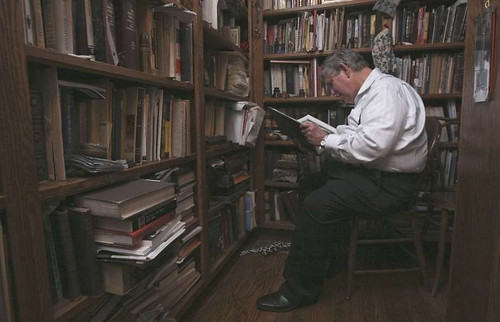
One of my best friends in life, Bob Chandler, died last night. I felt it in my sleep.
Dr. Robert Chandler, "Bob" to everybody, was a historian for the Wells Fargo Bank History Department for decades. I met Bob about 1980 through Doug McDonald, and we were best friends forever more.
Bob was a unique historian - one with a tremendous sense of humor, wit and an uncanny ability to tell stories. His specialties were certainly the Express business, but also Gold Rush monetary systems and California in the Civil War.
Our first mutual project was going to be a Wells Fargo display in Reno in 1983. We built cases, got everything ready, then the economy tanked, and we shelved the project.
My own passion for collecting rare western documents led to many discussions, as we learned things together about the western financial systems during and just after the Gold Rush and the Comstock rush. We wrote a number of short papers together on these matters, perhaps best summarized in one of our sales catalogs where we typed and listed western exchanges, and more. We got on a big roll with the Totheroh catalog, where Bob wrote several papers, including an important one that got left out for no reason by the company owner at the time.
Meanwhile, Bob had papers published in nearly every western historical journal, and gave well over 100 talks to various groups -maybe even 200!
At Wells Fargo, he shined. He constantly worked on advertising campaigns to be sure the information was well written (he wrote much of it himself), and properly well illustrated. He was a consummate historian, helping any of us who needed quality research that only he had access to. He was also a die-hard supporter of Bank President Anderson's "NO TRADE" policy of items within the Collection, of which some collectors were always after.
At home, I have a rubber cockroach named "Archie". I don't remember how in the heck it started, but Bob started talking about his pet cockroach Archie, and I adopted him ever since.
Bob and I shared a tremendous passion for western history. He, and he alone, was unarguably my biggest supporter through time, always pushing me, always encouraging me to make moves never done before. He was one of several people that were on my permanent "Peer Review" committee for my papers, and I on his.
When I ran mines, we often compared the historical systems of gold and money flow in antiquaria to today's systems. This led to a rather unique experience for me that in turn led Bob to recommend me for work on the SS Central America Project, for which I am forever grateful.
Just a month ago, he encouraged me to continue his work on GT Brown and write a paper on the competition between Brown and Britton & Rey, which I will do. Back in the early 1980's, it was Chandler who introduced me to Brown and I proceeded to find more Brown stuff for him and other collectors than is known today.
In later years, I visited Bob every chance I got in San Francisco. As I worked for various banks there and law firms on important historical projects, we'd share secrets, and of course lunch. Bob walked the streets of the financial district in his black top hat and bright red vest, a true "E Clampus Vitus" outfit!. He was so well known that local comic strip writers often included his persona in the comics of the Examiner.
In my world of western history, no other person had a greater impact on my life than Bob Chandler. God Bless Him!
We all - all of us - owe a great debt of gratitude to Bob. Never forget his humor. Never forget his depth of knowledge. Never forget his wit and charm. Never forget his love and charity.
RIP friend Bob!
Fred N. Holabird
To read the complete article, see:
On the Passing of Dr. Robert Chandler 2019
(https://holabirdamericana.com/2019/03/14/bob-palazzo-rip-2019-2/)
I'm sorry to hear the news. Thanks to Bob Evans, Harry Waterson and others who alerted me to this.
I believe I corresponded with Chandler once or twice over the years, probably concerning San Francisco eccentric emperor Norton and his scrip notes. Here's an excerpt from a March 12th, 2014 profile of Chandler from the Lamorina Weekly. -Editor
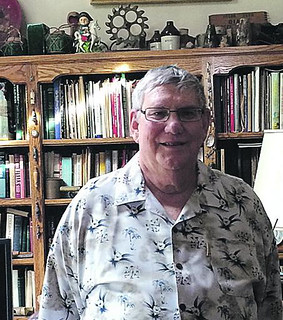 Walking into the back rooms
of Bob and Sue Chandler's lovely Lafayette home, you're not sure if you've entered a museum or a library. There are books, papers and artifacts
everywhere. It's hard to know where to look first.
Walking into the back rooms
of Bob and Sue Chandler's lovely Lafayette home, you're not sure if you've entered a museum or a library. There are books, papers and artifacts
everywhere. It's hard to know where to look first.
Chandler describes himself as a historian and a "pack rat." He's also an author, having just published "San Francisco Lithographer: African American Artist Grafton Tyler Brown," in addition to numerous magazine articles. His business card states "Dr. Robert J. Chandler, Western American History, Stagecoaching, Mining, Banking." None of that begins to describe this extraordinary man, who, according to Californiahistory.com, "is acclaimed by many California historians to be the premier authority on California in the Civil War and, in particular, San Francisco."
A trip to an antique shop in Port Costa in the '70s introduced Chandler to the world of historical items. "I found a letter having to do with the California State Telegraph Company from 1864 and it was $10. My first article was on the Overland Telegraph, so of course I had to buy the letter," he noted. "I suddenly realized that history wasn't found only in books." And the rest, as they say, is history. Chandler admits that while he still buys books, "I spend more money on photographs, pieces of paper, letters, something that will tell me a story. I'm on a first name basis with booksellers, antique and paper dealers everywhere."
To say Chandler is proud of his collections doesn't accurately express it. Spending an hour with him was like an historical show and tell. He showed off his collection of coral, decoys, mining equipment, crucibles for assays, Chinese ginger jars, candlesticks, tea pots, license plates, election posters, miniature German soldiers, lithographs, billheads, historical postcards and posted envelopes. He has a slide viewer from 1900 and San Francisco city directories dating back to the 1870s. And then there are his books - 9,000 of them, according to his wife.
Chandler is a longtime member of The Ancient and Honorable Order of E Clampus Vitus, a fraternal organization dedicated to preserving the American West heritage. The group often honors historical structures with one of its bronze plaques. However, as Chandler explained, "no one knows for sure if it's a drinking society interested in history or a historical society interested in drinking. And no one has ever been in any condition to resolve this debate."
Chandler spent 32 years as senior historian for Wells Fargo Bank, retiring in 2010. In that role, he said, he was "essentially the answer man" within the bank, dealing with both employees and consumers. He also wrote numerous articles on Wells Fargo's history.
He sits on the Board of the San Ramon Valley Museum and has loaned the organization items from his gold rush collection.
The family moved from Concord to Lafayette 16 years ago. "We had to find a house that could accommodate Bob's mistress - California history in all its forms," Susan Chandler said.
Describing her husband, she said, "When we first started dating, mutual friends told me Bob was eccentric; fortunately, I didn't know what that meant. Bob is constantly making history new. It's fascinating to watch him find something old and get excited about it. It is such a gift."
To read the complete article, see:
The Man of History
(http://www.lamorindaweekly.com/archive/issue0801/The-Man-of-History-Lafayette-resident-keeps-California-history-alive.html)
COL. STEVEN K. WHITFIELD (1940-2019)
Paper money author Steve Whitfield passed away on March 4, 2019. Here's an excerpt from his online obituary. -Editor
 Col. Steven Kent
Whitfield 78, (U.S. Army, Retired) passed away peacefully in his home on Monday, March 4th after a long illness. He was surrounded by his wife and
children.
Col. Steven Kent
Whitfield 78, (U.S. Army, Retired) passed away peacefully in his home on Monday, March 4th after a long illness. He was surrounded by his wife and
children.
He was born in Providence, RI to George E. & Grace K. Whitfield in November 1940. He proudly served 26 years as an officer and engineer in the U.S. Army. During his military career he attended Ranger School, Airborne School, Command General Staff College, completed two tours in Vietnam, and was awarded 2 Bronze Stars, the Silver Star, the Legion of Merit Medal, the Meritorious Service Medal, the Army Commendation Medal, Defense Service Medal, Vietnam Campaign and Service Medals.
Upon retiring from the military, he continued his work in the engineering field. He was a passionate historian and numismatist and is a published author on these topics.
He is survived by his wife of 55 years, Diana (Cabral) Whitfield, two children, Stephanie Kent Nielsen of Papillion, NE, and Jill Kent Whitfield-Wooley (and husband, Daryle) of Elkhorn, WI. He was a grandfather to Grace Kent Nielsen and William Darin Nielsen, and great-grandfather to Georgiana Whitfield Hunt.
He was a loving husband, father, and grandfather. He was happiest spending time with his family, working on his hobby, spending time by the ocean, and sharing funny stories. He will be greatly missed, but his legacy continues through his family who loved him deeply.
Steve will be buried with honors at Arlington National Cemetery in Washington, D.C. In lieu of flowers, donations may be made to the National Multiple Sclerosis Society (www.nationalmssociety.org) or the American Parkinson Disease Association (www.apdaparkinson.org).
To read the complete article, see:
Obituary for
Col. Steven K. Whitfield
(https://obittree.com/obituary/us/wisconsin/lake-geneva/steinke-lazarczyk-family-funeral-home-and-cremation-services/steven-whitfield/3767996/)

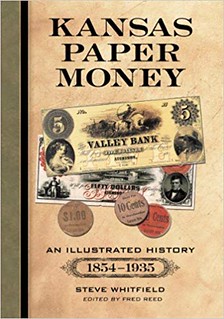
Wendell Wolka writes:
Steve was an old school paper money guy, always on the hunt for the historical info on his bank notes and other areas of interest to him. He authored two well written and researched books on Kansas obsolete notes. A fine gentleman always willing to lend a hand and share what he knew. I will miss him.
Mark Anderson writes:
He was a big part of the Society of Paper Money Collectors, wrote a column, and was very much a gentleman.
Loren Gatch of the SPMC writes:
Steven Whitfield began publishing in our journal as early as 1972, and did so for nearly forty years, in the last years as a columnist. He was also an officer of the SPMC, and served the organization in several capacities.
Whitfield published numerous articles in Paper Money, Bank Note Reporter, and The Check List, the official publication of the Check Collectors Round Table. His book on Kansas paper money won a Numismatic Literary Guild Extraordinary Merit Award in 2010, as well as runner-up for the SPMC's Wismer Award for Book of the Year.
Peter Huntoon writes:
My last contact with him at an International Paper Money Show or some such convention several years ago was after he had retired from the military. At that time, he was genuinely enthusiastic and energized by his current work for the Army Corps of Engineers on their major environmental restoration project to restore the hydrologic integrity of the Everglades in Florida. They were attempting to mitigate earlier work where land speculators had attempted to drain the Everglades, which partially dewatered the place thus causing major havoc to wildlife of every type including birds, fish and animals.
He was a key player in the construction of huge-scale levee water-retention and controlled-water-release structures that were designed to retard the runoff of fresh water from the Everglades swamps to the ocean. If I recall correctly, he mentioned that the project also was designed to facilitate recharge of surface water into the Floridan limestone aquifer under the Everglades region in order to mitigate sea water intrusion into that aquifer along the coast, which was despoiling aquifer water quality. This project was and continues to be a world-scale environmental restoration project that involved the heaviest of machinery and logistics.
I recall him telling me that he was living every civil engineer's dream by marshalling that scope of work using that scale of machinery supported by that size of a budget. He simply wasn't the least bit interesting in retiring. What I don't know is who he was working for; that is, as a direct contractor to the Army Corps of Engineers or one of the major engineering/construction contractors carrying out the work. In terms of his professional career, this was an achievement for which he wanted to be remembered.
In numismatics, he collected and delved into the history of obsolete and national currency from the locations he lived in, first Kansas, then Rhode Island and lastly Florida. He published as widely on at least Kansas and Rhode Island as the demands on his time from his professional life permitted.
Sorry to hear this. Thanks to Loren Gatch and others for alerting me to the news. -Editor
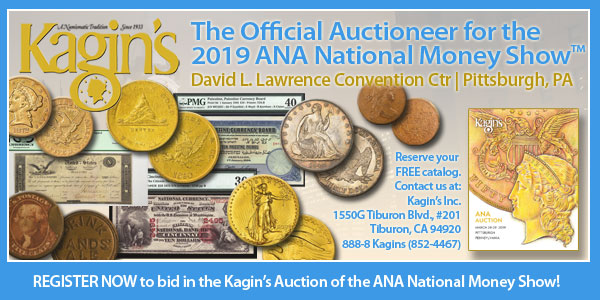
NEWMAN PORTAL ADS BITLER LARGE CENT NOTEBOOKS
The latest additions to the Newman Numismatic Portal are the Worthington Bitler (1900-1987) notebooks on U.S. large cents. Project Coordinator Len Augsburger provided the following report. -Editor
Who Cut The Auction Catalog Plates?
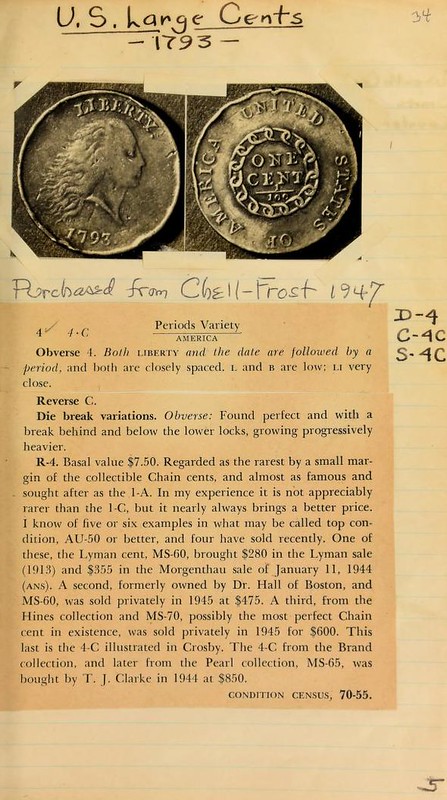 Recently scanned at the
American Numismatic Society under the sponsorship of Newman Portal are the Worthington Bitler (1900-1987) notebooks on U.S. large cents. These notebooks, c.
1945-1960, document a large cent collector’s quest to categorize information in a specialized area. Arranged in scrapbook style, the collector included clips
from published sources, personal notes, and plates cut from auction sale catalogs. The last represent a bibliophilic crime of high proportion, but one should
remember such plates were not especially prized at the time. Bitler was simply trying to put order to the universe, organizing notes and photographs for each
Sheldon variety.
Recently scanned at the
American Numismatic Society under the sponsorship of Newman Portal are the Worthington Bitler (1900-1987) notebooks on U.S. large cents. These notebooks, c.
1945-1960, document a large cent collector’s quest to categorize information in a specialized area. Arranged in scrapbook style, the collector included clips
from published sources, personal notes, and plates cut from auction sale catalogs. The last represent a bibliophilic crime of high proportion, but one should
remember such plates were not especially prized at the time. Bitler was simply trying to put order to the universe, organizing notes and photographs for each
Sheldon variety.
Volume no. 4 includes purchase records for the Bitler collection, which was comprehensive by Sheldon variety. Bitler’s prices paid were coded in Greek letters – here is a challenge for the numismatic linguist. The Bitler notebooks were no doubt carefully studied by Del Bland during his many visits to the ANS, and remain ripe for investigation by early U.S. copper researchers.
Link to Worthington Bitler notebook for U.S. large cents, vol. 1, 1793-1794:
https://archive.org/details/uscents179394vol00bitl
Link to Worthington Bitler notebook for U.S. large cents, vol. 2, 1795-1814:
https://archive.org/details/uscents17951814v00bitl
Link to Worthington Bitler notebook for U.S. large cents, vol. 3, 1815-1857:
https://archive.org/details/uscents181557vol00bitl
Link to Worthington Bitler notebook for U.S. large cents, vol. 4, purchase records:
https://archive.org/details/uscents17931857v00bitl
QUERY: A.W. SHAW ENGRAVED COLUMBIAN HALF
Web site visitor Timothy M. Bachman of Kalamazoo, MI writes:
I have an old coin that has engraving on it similar to a coin I found in an article you posted. I'm trying to get some info on this coin. It is an 1893 Columbian Exposition half dollar, it is engraved 4.5.93. and A.W. Shaw. The engraving is on the obverse side of the coin. Any info would be helpful and much appreciated. My coin is in excellent condition, looks to be uncirculated. I've had it for years, and I've never been able to find much out about it.
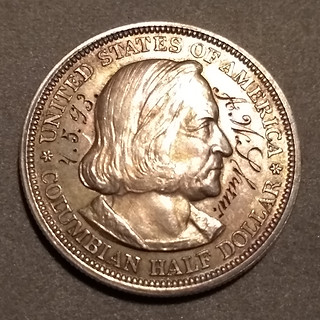
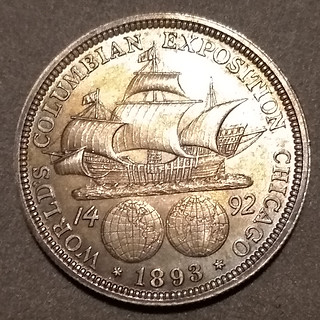
The article Tim found is about the engraved 1864 half Dollars made from silver recovered from the burned Masonic Temple in Boston. I offered to publish his piece here for reader comment, but Tim has already done some additional research. -Editor
Tim writes:
I did find out some info on A. W. Shaw, there is a Wikipedia article about him, and several other articles I've found. He was an entrepreneur from Jackson Michigan. I found the coin while coin roll hunting back in 2010. It was in a roll of half dollars that was all proof Kennedy halves, like someone had dropped off a coin collection at a bank. I was 28 when I came across the coin. I've kept it safe for almost a decade.
I am attaching the Wikipedia on Shaw, definitely worth reading. Turns out he is quite an interesting fellow. The company he started was very successful, and then baught by the McGraw-hill company in the 1920s, later they sold it.
Shaw would have been 17 years old when the coin was engraved, I'm wondering if it was a high school graduation gift. I'm wondering if there's any way anyone would be able tell who engraved it.
Arch Wilkinson Shaw (August 4, 1876 – March 9, 1962) was an American entrepreneur, publisher, editor and management theorist who applied the ideas of scientific management in the areas of offices and the tertiary sector.
During the First World War, Shaw served as Secretary of Commercial Economy Board, and later served as member of the board of directors of the Harvard Business School.
Shaw was born in 1876 in Jackson, Michigan, son of James Franklin Shaw and Estelle Jane (Fenn) Shaw. After attending public school, he quit his studies at Olivet College. He would eventually obtained his AM degree from Olivet College in 1914, and would obtain his doctor of laws from Northwestern University in 1927.
Shaw broke off his studies at the Olivet College before graduating in 1899, at the age of 23, and founded, with Louis C. Walker, the Shaw-Walker Company in Muskegon Michigan,specializing in office supplies and plugs and files.
Four years later, in 1903, while still in the board of directors of the firm, he founded the Shaw Company, which published the reviews System, The Magazine of Business, specializing in the service and offices (typing, office furniture, etc.), and Factory. The firm also published books on management. Shaw sold it in 1928 to the McGraw-Hill Company.
Turns out he was good friends with Herbert Hoover, and even an advisor to him. It was also him who funded the Harvard business school, and the first to teach business at Harvard. I also found that he was co-founder of the Kellogg company.
To read the complete Wikipedia article, see:
Arch Wilkinson Shaw (https://en.m.wikipedia.org/wiki/Arch_Wilkinson_Shaw)
To read shaw's New York Times obituary (subscription required), see:
ARCH SHAW DIES; EX-PUBLISHER, 85;
Business Magazine Leader Was Adviser to Hoover
(https://www.nytimes.com/1962/03/11/archives/arch-shaw-dies-expublisher-85-business-magazine-leader-was-adviser.html)
So is this the A.W. Shaw associated with this coin? The circumstantial evidence is strong, but there's no proof. On a whim I searched the Newman Numismatic Portal for A.W. Shaw which led me to a 1994 Coin World article mentioning an "A W. Shaw" in The Numismatist in 1891. So I logged on to my American Numismatic Association account and repeated my search there.
In the July 1891 issue I found this (referencing the proposed founding of the American Numismatic Association):
The A.N.A., is O.K. A. W. Shaw, Jackson Mich.
In the August 1891 issue I found this:
"The Collectors Journal of Jackson Mich., wants an editor for its numismatic department. We should be pleased to see this want filled by some of our numismatic frends. Address; A. W. Shaw, Jackson, Mich." -Editor
So this A. W. Shaw was a an early subscriber to The Numismatist before the founding of the ANA, and published his own collector magazine. He would have been 15 at the time. What do readers think? Did the engraved Columbian Half belong to him? I reached out to NBS Historian Joel Orosz, also of Kalamazoo.
Joel writes:
I was for several years a Program Director at the W. K. Kellogg Foundation in Battle Creek. I was quite interested in the biography of the man—Will Keith Kellogg—who was the founder of both the Kellogg Company and the Kellogg Foundation.
In the early years of the Kellogg Company (founded 1906), Arch Shaw was a close adviser to Mr. Kellogg. He remains a respected figure in the history of business.
I think it is likely both that the engraved Columbian half belonged to Shaw, and that he was associated with the short-lived i>Collector’s Journal in Jackson.
However, it appears that Shaw’s interest in numismatics did not extend into the 20th century, for he seems to go quiet after getting the half engraved.
To read the earlier E-Sylum article, see:
1864 MASONIC ENGRAVED HALF DOLLAR (https://www.coinbooks.org/esylum_v17n23a19.html)
NOTES FROM E-SYLUM READERS: MARCH 11, 2019
CONTAMARCHE F.C. MARINO Token
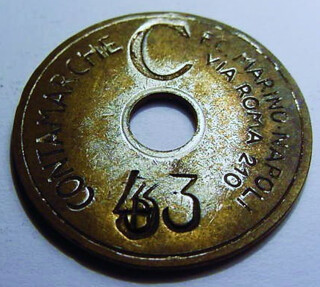 On our Flickr image
archive Ernesto Brando writes:
On our Flickr image
archive Ernesto Brando writes:
Do you know what is this, please?
The piece was pictured in my April 8, 2018 Numismatic Nuggets column. I'd come across it online and asked our readers the same basic question. I had to tell Ernesto I was still stumped - no one had written in with a response. My only guess was that it looks like a tool check of some kind. Guesses, anyone? -Editor
To read the earlier E-Sylum article, see:
NUMISMATIC NUGGETS: APRIL 8, 2018 : CONTAMARCHE F.C. MARINO Token
(https://www.coinbooks.org/v21/esylum_v21n14a25.html)
Query: King Farouk, Numismatist
Web site visitor Moe Rizkalla writes:
I'm an Egyptian numismatist and was wondering if you or your readers have any material to help me further study King Farouk as a numismatist? Looking at the archive I found this article mentioning some Farouk related material but it's 12 years old. I wonder if anyone has something similar that I can study? Thanks in advance!
Tough question - I'm not sure there's any one go-to resource. Of course there is the Sotheby Farouk sale catalog, but that only lists the coins with little on the collector. Dave Bowers' book on Abe Kosoff probably has information, and there would be a lot of articles in the numismatic press. i guess I would suggest starting with the Newman Numismatic Portal and using advanced search to limit results to periodicals.
Any other thoughts? -Editor
To read the earlier E-Sylum article, see:
DICK JOHNSON'S SCHULMAN-FAROUK ARCHIVE (https://www.coinbooks.org/esylum_v10n36a06.html)
To visit the Newman Numismatic Portal:
https://nnp.wustl.edu/
More on Guttag Brothers Store Cards
Regarding varieties of the Guttag Brothers storecards, George Kolbe passed along this useful link to a March 16, 2014 discussion on the Collector's Universe forum. -Editor
1923-1926 Guttag Brothers, 30mm Diameter, Rare Coin Dealer Store Cards, Struck by Medallic Art Company / Sculptor Jonathan M. Swanson
Last year I had a chance to purchase a high grade collection of Guttag Bros rare dealer store cards in 3 phases which was assembled in the 1940-50's. The obverse of each features a allegorical scene of a nude muse holding the lamp of knowledge for a boy to study a coin along with 3 different reverse designs. I bought the full collection including all the different metal type duplicates. Since only the bronze column flanked framed reverse design issue is common, however still tough to find variety as a fully struck early die stage without excessive die erosion. I am keeping it intact since this is without a doubt the most complete private collection ever assembled as only American Numismatic Society museum collection holdings come close.
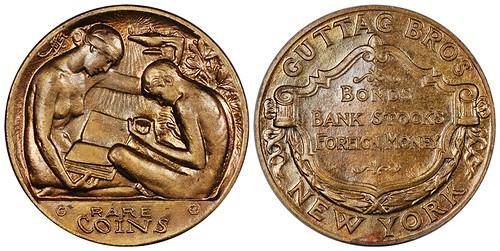
Thanks, George. I counted 28 varieties in multiple medals. Great collection, posted by "Broadstruck". -Editor
To read the complete discussion, see:
~ Guttag Brothers Rare Coin Dealer Store Cards ~
(https://forums.collectors.com/discussion/913236/guttag-brothers-rare-coin-dealer-store-cards)
Not to Be Used to Buy Elections Overstamp
Paul Cartmill writes:
It was interesting to read about the "stamp money out of politics" stamp in last week's E-Sylum. Here is my contribution - I got this in my change last fall out here in sunny California.
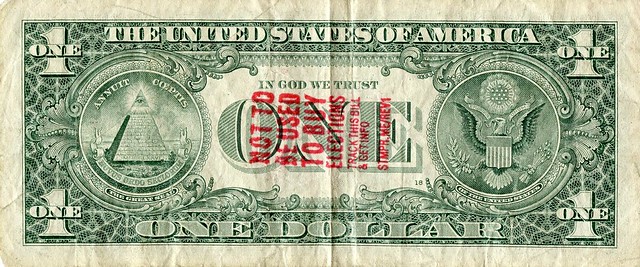
Thanks. This is a similar political sentiment to the Zero Rupee anti-corruption notes in India. -Editor
To read the earlier E-Sylum articles, see:
NOTES FROM E-SYLUM READERS: MARCH 10, 2019 : The Stamp Money out of Politics Overstamp
(https://www.coinbooks.org/v22/
esylum_v22n10a09.html)
THE ZERO RUPEE ANTI-CORRUPTION NOTE (https://www.coinbooks.org/esylum_v19n21a36.html)
Mystery Coin - A Local Coinage Issue?
John Linhoss writes:
I found this coin between the pages of "Coins of the World" by William D. Craig's first edition 1966. I took it to the Baltimore Coin Show in 2016 and asked around about it. Chris Maniscalco at The Sentry Box seemed to believe it was a type of local coinage. Dr. Mike Shutty,a close friend, thought it be best to send it to The E-Sylum. One thing is for certain, it is not listed in the book I found it in.
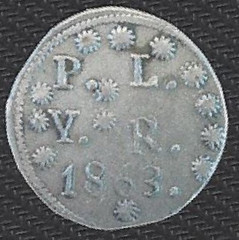

Can anyone help? -Editor
Mystery Token - Communion Token?
John Linhoss writes:
Some years ago, once again at the Baltimore Coin Show, I asked Steve Tanenbaum, who sadly passed away, told me he thought it French. He also said it may be a communion token. Well, I have Burzinki's "Communion Tokens of the World" I acquired from Steve Hayden and I didn't see it in there. I was wondering if any of your subscribers could help.
Jean Paul Divo
Regarding Charlie Davis' photo from the 1981 New Orleans ANA convention, Jeffrey S Zarit writes:
I believe the gentleman sitting on Dick Margolis's left is Jean Paul Divo and at that time, he was at Bank Leu in Zurich; and the lady across was Sylvia Hurder (or Hunter) whom I never met but knew of her. This would be from the 1970's I think.
Thanks. Richard Margolis is at the lower left. -Editor
To read the earlier E-Sylum article, see:
WAYNE'S NUMISMATIC DIARY: MARCH 10, 2019 : Charles Davis
(https://www.coinbooks.org/v22/esylum_v22n10a21.html)
1862 Curtis Catalog Sought
Craig Sholley writes:
As part of the research John Dannreuther and I are doing on the New Haven Restrike Fugio's, we are seeking a copy of John K. Curtis' 1862 catalog and fixed price list. Electronic scan is fine for now, but I would like a period copy for my collection. Please email craig.sholley@yahoo.com.
Random Numismatic Book Sighting
While in London earlier this week Howard Berlin sent this report:
I was on the Piccadilly line going back to my hotel near Heathrow. Sitting next to me was a woman with two friends. What caught my eye was that she was reading a copy of the book, "Hay Internment Camp Notes &? War Savings Certificates (2nd ed.)?" by Michael P. Vort-Ronald! I wasn't familiar with that camp, but after briefly talking with her, she is an Aussie non-numismatist and Hay is in New South Wales, Australia.
How rare is that!? Outside of coin events I can't say I've ever encountered a stranger reading a numismatic book. Great story. We have discussed the Hay notes before, but not the book. -Editor
To read the earlier E-Sylum articles, see:
AUSTRALIA CAMP SEVEN BANK INTERNMENT CAMP NOTES
(https://www.coinbooks.org/v20/esylum_v20n49a25.html)
HIDDEN MESSAGES IN HAY INTERNMENT CAMP NOTES
(https://www.coinbooks.org/v21/esylum_v21n41a22.html)
2019 ANA Summer Seminar on Medallic Washington
David Menchell submitted this note about the 2019 ANA Summer Seminar. -Editor
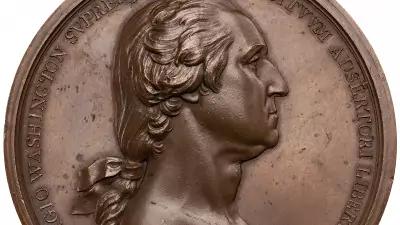
I thought that readers of The E-sylum considering attending the ANA Summer Seminar this year would be interested to know that once again, I will be teaching a course related to Medals. This year, I will be joined by Neil Musante, author of the superb updated reference on Washingtoniana, Medallic Washington. We will be exploring the wide range of material depicting George Washington. The course will be offered during the first session, from June 16 to 19. The course description follows:
Medallic Washington: Images of Our First President in Numismatics
George Washington’s image appears on virtually every category of post-colonial Americana, from coins, tokens, medals and patterns to commemoratives and even
pioneer gold. This course will cover the spectrum of Washington issues from the past to the present, with special attention paid to the earliest coins and
medals, special rarities, and fantasies, fakes and forgeries.
Instructors: Dr. David Menchell, medals expert; and Neil Musante, author, Medallic Washington, Volumes 1 and 2
A great opportunity to learn from the experts! The Summer Seminar is one of the great achievements of the American Numismatic Association. Everyone should find a way to attend sometime. -Editor

THE WILLIAM BARBER GRAVESITE
Heath MacAlpine submitted this article about his experience visiting the gravesites of the Chief Engravers of the United States Mint. Thanks! -Editor
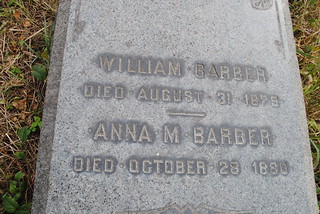 How interesting to view the photographs of William Barber and his wife Anna, and how generous of the Barber
descendants to share them. Seeing them reminded me of the ANA summer show in Philadelphia in 2012. In addition to collecting medals, I’m also a cemetery buff,
so I decided to combine the two hobbies that year. I took a day to visit the graves of several of the Chief Engravers of the United States Mint.
How interesting to view the photographs of William Barber and his wife Anna, and how generous of the Barber
descendants to share them. Seeing them reminded me of the ANA summer show in Philadelphia in 2012. In addition to collecting medals, I’m also a cemetery buff,
so I decided to combine the two hobbies that year. I took a day to visit the graves of several of the Chief Engravers of the United States Mint.
I found George Morgan and James Longacre at The Woodlands Cemetery, while Barber’s son Charles was interred at Mount Peace Cemetery. Longacre’s memorial was very grand, Morgan’s very modest, and Barber’s somewhere in-between. William Barber, though, was at Mount Moriah Cemetery.
Mount Moriah was a grand 19th century cemetery and the final resting place of many historic Philadelphians. Unfortunately, it had fallen on hard times in the second half of the 20th century. The owners gradually stopped maintaining whole sections of the property, finally abandoning it altogether. Trees, chest high shrubs and grasses had taken over, submerging all but the tallest monuments. Barber was somewhere in this sea of vegetation.
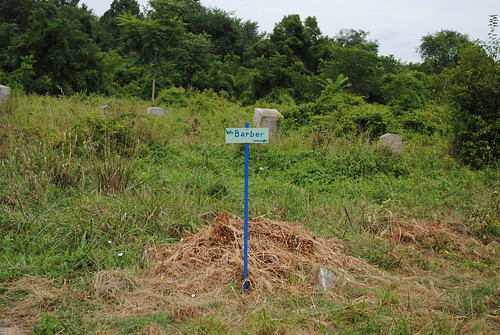
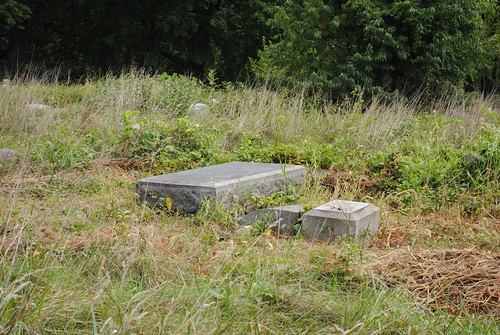
I did some research and reached out to the Friends of Mount Moriah Cemetery, a volunteer group that has been waging a long and successful campaign to gain oversight of the property and begin reclaiming it from the wilderness it had become. Rob Hobdell, one of the volunteers working with the group, was able to locate the grave and to run an industrial strength mower through the encroaching plant-life prior to my arrival. He then escorted me to site.
Barber and his wife are buried under a 7 foot by 3 foot granite slab. Two of their children, Mary and Florence, share the grave with them. There’s nothing on the slab or at the site to indicate Barber’s numismatic connections, no sign of 20 cent pieces or trade dollars. Rob and I explored some more until a nest of yellow jackets sent us on our way.
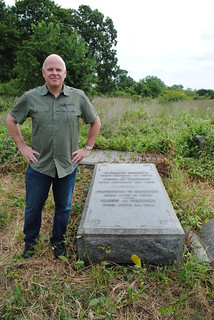
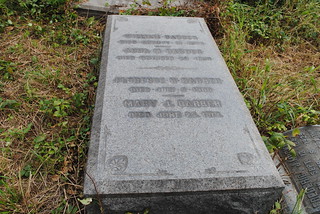
I thanked Rob and the other volunteers and gave the Friends an example of the Grant Presidential medal done by Barber as a token of my appreciation. In checking current satellite pics of the location on Google Maps, it looks like the Friends are keeping that section mowed these days, making visiting easier. If you want to go, Barber was at N 39.93596 W 075.24033 the last time I saw him.
Thanks for the report. Sorry to hear that news, but glad to hear some volunteers are working on the site. -Editor
To read the earlier E-Sylum article, see:
PHOTO OF ENGRAVER WILLIAM BARBER FOUND
(https://www.coinbooks.org/v22/esylum_v22n10a05.html)
DICK JOHNSON WELCOMES QUESTIONS FROM READERS
Below is a photo of Dick Johnson taken earlier this week. He's been dealing with a longstanding medical condition, but is feeling well and looking forward to hearing from his fellow numismatists. -Editor
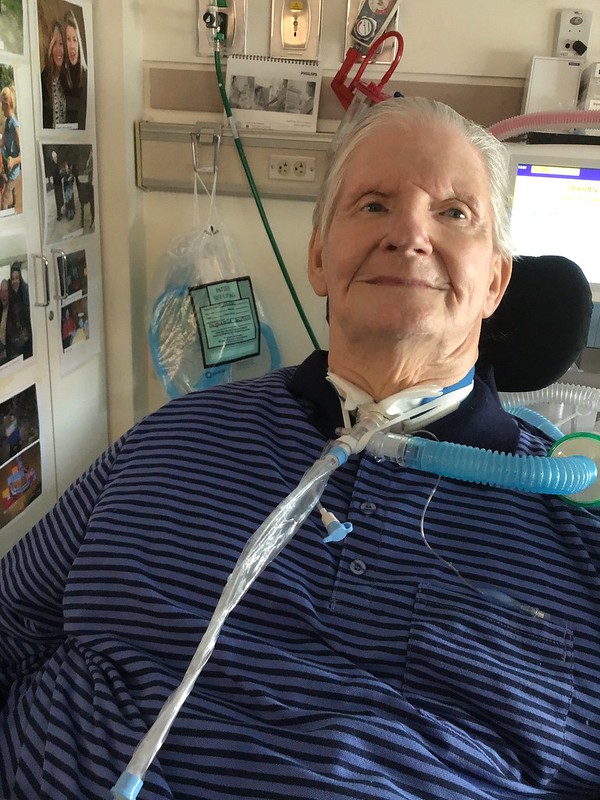 A pair of medical conditions
has sent numismatic author Dick Johnson to rehabilitate at a Connecticut Hospital in recent months. His most serious condition is Inclusion Body Myositis --
called I.B.M. for short -- which causes muscle cells to deteriorate in the legs and other locations in the body. IBM is a rare condition with perhaps less than
500 patients in Connecticut. His doctor states Dick is his oldest living patient with IBM.
A pair of medical conditions
has sent numismatic author Dick Johnson to rehabilitate at a Connecticut Hospital in recent months. His most serious condition is Inclusion Body Myositis --
called I.B.M. for short -- which causes muscle cells to deteriorate in the legs and other locations in the body. IBM is a rare condition with perhaps less than
500 patients in Connecticut. His doctor states Dick is his oldest living patient with IBM.
He has had this condition for more than 5 decades. For the first 28 years he was diagnosed as Peripheral Neuropathy as his doctor did not recognize the rare medical condition. It was only when he found a doctor specializing in IBM that he was diagnosed correctly in 2008.
Patients with IBM normally lose two percent of their muscle mass per year. Dick's started with weakness in the legs in the 1980's and progressed to occasional falling which led to using a wheelchair for mobility by 2008. More recently, Dick's IBM condition has spread to the muscles in his throat. Neither conditions are life threatening and his muscle loss has leveled off.
Per Dick's wife Shirley, he spends the bulk of his time reading. Dick will be 89 in August and would welcome e-mails from old friends and new authors with questions on the technology of how coins and medals are made. He is an authority on this subject, having written An Encyclopedia of Coin and Medal Technology. Dick's e-mail address is dick.johnson@snet.net.
VOCABULARY TERMS: TEST CUT, TEST MARK
Dick Johnson submitted these entries from his Encyclopedia of Coin and Medal Terminology. Thanks. -Editor
Test Cut, Test Mark. A purposely made cut into the edge of a numismatic item by unthinking people to ascertain the item's base composition. Usually this occurs to a plated piece, but even solid metal items – particularly precious metals, gold and silver – are susceptible to such unfortunate practice. People who make test cuts are not professionals, but amateurs who think a test cut is considered a way to make a quick assay of the item's fineness. Unfortunately this practice is a mutilation of the item and it lowers both numismatic condition and value.
Instead, to ascertain the base metal a specific gravity test or other nondestructive tests should be conducted. Only if these are inconclusive, should a very light file cut be made in the most unobtrusive part of the rim where a magnifying glass would reveal the color of the base metal (but even file cuts are discouraged by some).
In America the mutilating test cut (where metal is removed) is also called a knife cut, in both Britain and the continent, a chisel cut. Cuts in silver objects, usually near the hallmarks were once called assay groove in previous centuries. An unintentional, but sometimes similar defect on the edge – as from dropping a piece – is called edge nick; the two should not be confused.
The purpose of the test cut is to identify the color of the underlying metal. This may not be obvious at first inspection, for example, copper may appear pink instead of red. For other color identities see bleeding.
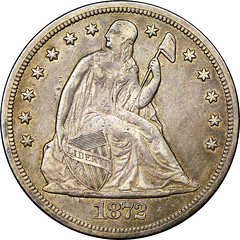

Images from NGC Coin Explorer
Test marked coins. Breen relates the history of four dates of Carson City silver dollars, 1870-73, which often exhibit test marks. After claims were made that these CC dollars were lightweight and low fineness, the Philadelphia Mint ordered samples sent to them for assay. This proved to be true, resulting in the dismissal of the Carson City Mint Superintendent, H.F. Rice. Publicity of this caused widespread testing of these dollars by banks and individuals, with many returned for melting. A few remaining specimens still exhibit test marks where this testing once occurred. The gold coins struck at Carson City of the same period were also suspect but Breen did not report observing test marks on any of these.
Never perform a test cut to the edge of any coin or medal. This drastically lowers the value and such an item is considered damaged. If you are seeking the identity of the base metal or under composition it is best to perform a nondestructive specific gravity test. If this is inconclusive, then have a professional perform a file cut for a microscopic examination of the base metal. Do not perform test cuts yourself!
References:
NC7 {1988} Breen [dollars 5485, 5489, 5493, 5495].
Looking for the meaning of a numismatic word, or the description of a term? Try the Newman Numismatic Portal's Numismatic Dictionary at: https://nnp.wustl.edu/library/dictionary
Or if you would like a printed copy of the complete Encyclopedia, it is available. There are 1,854 terms, on 678 pages, in The Encyclopedia of Coin and Medal Technology. Even running two a week would require more than 19 years to publish them all. If you would like an advance draft of this vital reference work it may be obtained from the author for your check of $50 sent postpaid. Dick Johnson, 139 Thompson Drive, Torrington, CT 06790.
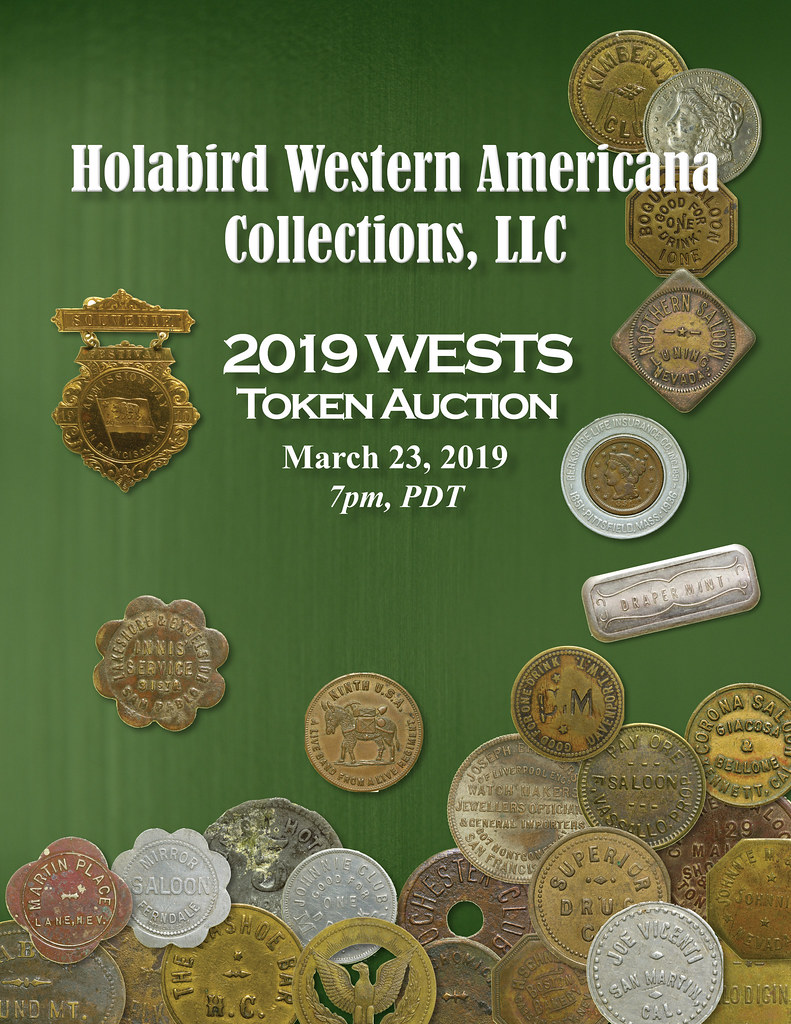
WILLIAM HARVEY STROBRIDGE (1822-1898)
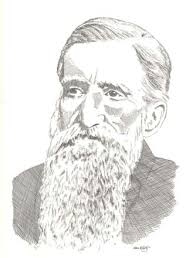 The Strobridge stamp, coin, book, curio and antique dealership from 1862 to 1879 was a father and son family run
business. From 1871-1878 he worked as a cataloguer for the George A. Leavitt & Company, auction house. Strobridge catalogued 29 sales of coins, and his son
Timothy catalogued 8 coin sales.
The Strobridge stamp, coin, book, curio and antique dealership from 1862 to 1879 was a father and son family run
business. From 1871-1878 he worked as a cataloguer for the George A. Leavitt & Company, auction house. Strobridge catalogued 29 sales of coins, and his son
Timothy catalogued 8 coin sales.
William Harvey Strobridge (1822-1898), was born on January 9, 1822 at Barnet, Caledonia County, Vermont, son of Ebenezer Hinds Strobridge (1785-1878), and Elizabeth Kerr Harvey Strobridge (1787-1847).
He grew up with Henry Stevens who later became a renowned London collector.
On Christmas Day 1847, he married Margaret Lucretia Rix (1829-1855). They had three children : Harriet Elizabeth Strobridge (1848-1938), William Arthur Strobridge (1850-1860), and Timothy Rix Strobridge (1852-). Some report that they moved to New York in 1851 and others say 1853. He worked as a salesman for Fairbanks scale company.
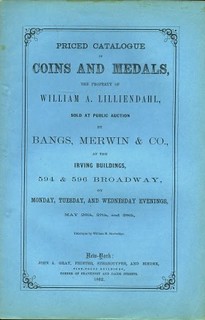 Strobridge began to acquire Pompeian frescoes, including the terra cotta painted portrait of Hebe, that had
gone into a Boston Exhibition in 1855.
Strobridge began to acquire Pompeian frescoes, including the terra cotta painted portrait of Hebe, that had
gone into a Boston Exhibition in 1855.
On June 12, 1858, he married Sarah Janette Wilcox (1829-1906). They had a daughter Minnie E. Strobridge (1863-)
They briefly relocated to Baltimore, Maryland for Fairbanks scales. He also brought his collection of carved gems.
On Christmas Day 1860, visiting in-laws at Barnet, Vermont, the eldest son William Arthur Strobridge died at the home of Walter Harvey.
Tim Strobridge grew up during his father's business days as a dealer and learned the trade from him. However, he lacked his father's talent as a cataloguer.
He catalogued the 1230 lots of the William A. Lilliendahl collection and sold it at Bangs, Merwin & Company, New York, on May 26-28, 1862. The collection contained 170 Large Cents.
In the spring of 1878 he retired due to blindness necessarily handing the business over to his only surviving son Timothy Rix Strobridge (1852-1881), commonly known simply as T. R. Strobridge.
The 1880 U.S. Census lists him as a dealer in coins.
 In July 1886, The Brooklyn Daily Eagle, Sunday
edition ran a story on W. H. Strobridge and his Curiosity Shop. The article tells us that Strobridge lost his eyesight several years ago costing him loss of
employment. Moreover, his loss of sight did not interfere with his poetic compositions. He kept a curiosity shop in his sitting room at his residence. His
collections included gems, terra cotta paintings, snuff boxes, Egyptian scarabs, seal rings, coins, medals, and tokens.
In July 1886, The Brooklyn Daily Eagle, Sunday
edition ran a story on W. H. Strobridge and his Curiosity Shop. The article tells us that Strobridge lost his eyesight several years ago costing him loss of
employment. Moreover, his loss of sight did not interfere with his poetic compositions. He kept a curiosity shop in his sitting room at his residence. His
collections included gems, terra cotta paintings, snuff boxes, Egyptian scarabs, seal rings, coins, medals, and tokens.
He died on Saturday, December 17, 1898, at his home 347 Greene Avenue, Brooklyn, New York. He is buried in Greenwood Cemetery, Brooklyn, Kings County, New York.
To read the complete article, see:
STROBRIDGE, WILLIAM HARVEY
(https://sites.google.com/a/numismaticmall.com/www/numismaticmall-com/strobridge-william-harvey)
The entire inventory of the Lupia Numismatic Library is for sale. Individual items will be available before the remaining archives are broken up into parcels sold at philatelic auctions in the U. S. and Hong Kong. Check NumismaticMall.com frequently as dozens of new items with estimates will be posted daily until everything is sold.
All inquiries will be given prompt and courteous attention. Write to: john@numismaticmall.com .
BEP BANKNOTE DESIGNER BRIAN THOMPSON
On March 13, 2019 Quartz published a nice interview with BEP banknote designer Brian Thompson, the first African-American person to design a U.S. banknote. Here's an excerpt. -Editor

Take the $100 bill. Redesigned in 2013 after a spate of high-tech counterfeiting based out of North Korea, the new note features some of the most advanced security design in the world. It cannot be photocopied, reveals some of its secrets only under the infrared and ultraviolet lights of banks and vending machines, and includes a security ribbon allegedly “impossible for even North Korean counterfeiters to replicate.” Or, at least, very, very difficult.
Behind this note is Brian Thompson, one of the US’s three current journeyman banknote designers, as they’re officially known. In 2013, he became the first African-American person to design an American banknote, nearly 25 years after he first arrived at the Bureau of Engraving and Printing as an apprentice. His father had previously worked for the bureau, manufacturing the cylinders that pull the “paper” through the presses and turn it into money.
Though billions of people have seen, held and used Thompson’s artwork, most of them have no idea which invisible hand is behind the subtleties of orange and green on this 6.14 by 2.61 inch canvas. All banknotes are signed, but not by their artists. In an interview with Quartz, Thompson explains how he got to where he is and what makes his chosen canvas so challenging.
Quartz: How did you become a banknote designer?
I graduated out of high school in ‘88 and started a seven-year apprenticeship as a banknote designer in ‘89. At that particular time, there were two apprentices, including me, and six full-fledged journeyman banknote designers when I first started. There were only eight of us then—so it’s always been a small number of us. I’m now one of the three banknote designers of the United States.
What does a typical day look like?
A typical day is a lot of research towards the subject matter that we’re thinking about designing, even if there isn’t a specific assignment. We’re designing to stay ahead of the calendar. Our days are always full of meetings with the Federal Reserve and the Treasury Department. We’re getting feedback and information from all of them. Otherwise, we keep our skills sharp by designing miscellaneous products or imagery. We’ll draw new subject matter, though I can’t give detail on that. Sometimes this is work that no one will ever get to see because it’s work that’s building toward a final product, or final drawings. We try to do it to just to stay sharp and ahead of the effects of new technology.
With the $100 bill, you were the first African-American person to design a banknote. Could you tell me a little about that?
I was the the first African-American to design American currency. A reason why that was special was because I worked with the first two African-Americans who did banknote design before they retired and passed. The first African-American banknote designer in the history of the United States was Ronald C. Sharpe, and the second African-American banknote designer was Clarence Holbert. They both trained me. But neither one of them had the opportunity to design American currency because at that time, they weren’t making any changes [to US banknotes]. Holbert on the other hand, spent the latter part of his career designing the currency for the country of Eritrea.
To read the complete article, see:
The incredibly secretive process of designing the next US
banknote (https://qz.com/1571387/banknote-designer-brian-thompson-on-how-money-is-designed/)
50-YEAR AMERICAN NUMISMATIC SOCIETY MEMBERS
The ANS has recognized a number of its members who have reached the amazing 50-year mark. Congratulations! Here's a statement provided by ANS Director of Development Eshel Kreiter. Thanks. -Editor
A Significant Milestone
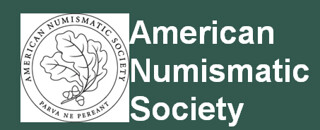 One of the most significant forms of support for the ANS, and one the Society values deeply, comes from ANS members who consistently maintain their membership
in the Society year in and year out. The ANS is honored by this show of unwavering dedication and gratefully acknowledge those who have reached the significant
milestones of 25 years, 30 years, 40 years, and—most remarkably—half a decade of continuous membership in the ANS. Those who have now reached the 50-year-mark
are recognized as Life Members and join this elite rank of the American Numismatic Society.
One of the most significant forms of support for the ANS, and one the Society values deeply, comes from ANS members who consistently maintain their membership
in the Society year in and year out. The ANS is honored by this show of unwavering dedication and gratefully acknowledge those who have reached the significant
milestones of 25 years, 30 years, 40 years, and—most remarkably—half a decade of continuous membership in the ANS. Those who have now reached the 50-year-mark
are recognized as Life Members and join this elite rank of the American Numismatic Society.
Mr. Stephen Album - ANS Fellow
Mr. Arthur Ray Doumaux Jr.
Mr. Dennis Gill
Mr. Lawrence S. Goldberg - ANS Fellow
Dr. R. Craig Kammerer
Mr. Donald J. Orth
Mr. Harvey Stack - ANS Fellow
Mr. Michael R. Zagorin
Mr. George F. Kolbe - ANS Fellow
There are a number of NBS and E-Sylum regulars here. Of particular note are longtime contributor Harvey Stack and NBS co-founder and numismatic literature dealer George Kolbe. Congratulations to all on this major milestone. -Editor
For more information on the American Numismatic Society, see:
http://numismatics.org/
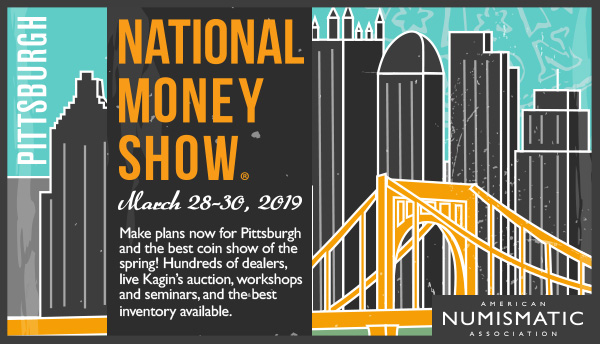
1896 ARGENTUM UNIVERSALE ONE TALENT OFFERED
Mark Borckardt of Heritage Auctions reports that an example of the rare 1896 One Talent will appear in their 2019 Central States sale next month. Thanks. Mark provided an image and lot description text. -Editor

Private Coinage Proposal
Perhaps Three Examples Known
1896 One Talent, Judd-Unlisted, Krause X#2, Uncirculated Uncertified. 37.0 mm., 32.59 grams. The obverse depicts a map of the Eastern hemisphere with the legend ARGENTUM - UNIVERSALE and the date. The reverse depicts a map of the Western hemisphere with the legend UNITED STATES OF AMERICA and ONE TALENT. These pieces, reported as one part gold to four parts silver, are attributed to Mr. Emil Greeff who was identified in a May 14, 1896 newspaper article appearing in The Newark Daily Advocate, repeating an article from the New York Herald. William Woodin displayed examples of each size at the 1914 ANS exhibition, although neither was illustrated.
In Our August 2017 ANA Sale, we offered an 1896 fifth talent, the only example of this distinctive, privately produced pattern issue that we had handled at any time in the company’s history. The smaller fifth talent is 24.3 mm. and 6.5 grams, while this larger piece is 37.0 mm. and 32.59 grams. Stack’s Bowers handled an example of each size in Part 23 of the John J. Ford, Jr. Collection, both earlier from F.C.C. Boyd, and a worn example of the larger size one talent piece was illustrated in the July 2, 2017 edition of the email newsletter, E-Sylum.
An example of the one talent denomination was displayed at the April 11, 1934 meeting of the Brooklyn Coin Club, although its provenance is unknown. Richard Kenney mentioned and illustrated the one talent piece in the June 1962 installment of “Unofficial Coins of the World” that was published posthumously in The Numismatist. The illustrated piece may be a fourth example of this issue as it does not appear to match the others.
While some evidence of cleaning appears at the center of the obverse and reverse, this sharply detailed example has pleasing gold toning over its still lustrous surfaces with no evidence of wear. As one of just three examples that we know of, this opportunity is tremendously important. While not an official pattern issue of the United States, these pieces deserve a place in an advanced cabinet as experimental pieces toward an international coinage.
This is an important private pattern, and a great condition example at that. I expect spirited bidding. -Editor
To read the earlier E-Sylum article, see:
1896 ARGENTUM UNIVERSALE ONE TALENT LOCATED
(https://www.coinbooks.org/v20/esylum_v20n27a13.html)
SEDWICK MAY 2019 SALE HIGHLIGHTS
The press release describes highlights from the May 2-3, 2019 auction by Daniel Frank Sedwick, LLC. -Editor
A rare, early Argentinean gold coin in a remarkably high grade is coming up for auction May 2-3 as part of Daniel Frank Sedwick, LLC’s Treasure, World, US Coin & Paper Money Auction 25.
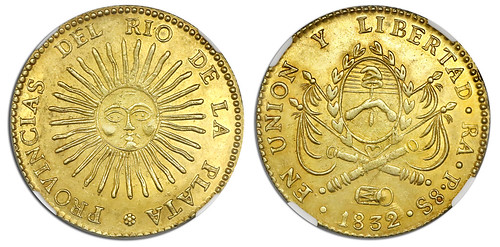
The top coin lot is an Argentina gold 8 escudos struck in 1832 at the La Rioja mint. The coin exhibits an overdate of 1832/1 and is graded by NGC as MS 62, a rare grade for the type. It is pedigreed to numismatist George Gund III’s collection. The obverse of the coin depicts a sunface, a common design found in post-colonial Latin American coinage. The coin is estimated at $20,000 and up.
The sale will also host a number of ingots recovered from famous shipwrecks. One such ingot is a large gold bar from the Tumbaga wreck which sank around 1528 off Grand Bahama Island. The bar weighs 1.816 kilograms and contains 9 karat gold with a balance of silver, copper, and other trace metals. The early Spanish colonial bar also bears the tax stamps of Holy Roman Emperor Charles V. It is estimated at $35,000 to $50,000.

Tumbaga gold bar
Another gold bar and four silver ingots from the wreck of the Atocha, sunk in 1622 off Key West, Florida, are also available for bidding. The largest silver bar weighs 92 troy pounds, 3.84 troy ounces and features markings from the owner, Arriola, and the assayer, Mexia. The bar is accompanied by the original salvager’s certificate as well as stock certificates originally issued for the salvage company. The estimate on the bar is $30,000 and up.
The gold bar from the Atocha weighs 622 grams and has a gold fineness of 20-1/4 karats. Its long, thin shape led to its modern day nickname of “finger” bar. The surface of the bar shows markings for the fineness, foundry, owner, and seven tax stamps. The lot also includes the original salvager’s certificate. The ingot is estimated by the auction firm at $25,000 to $37,500.

Atocha gold bar
Shipwreck coins will make a big showing in the auction. In a rare occasion, a pair of gold Seville, Spain cob 2 escudos, one each from the Atocha and its sister ship Santa Margarita that sank at the same time, will appear in the sale. The Atocha 2 escudos is dated 1617 and estimated at $7,000 to $10,000. The Santa Margarita 2 escudos bears a partial date from the 1620s and is estimated at $6,000 to $9,000.
Another shipwreck artifact of historical importance is a 22-karat, 42” long gold chain from the “Cabin wreck” site of the 1715 Fleet. The fleet sank on July 31, 1715 off the east coast of Florida during a hurricane while carrying treasure to Spain. On July 21, 1964, the chain was recovered and documented by the salvage company Real Eight Company. Supporting documents attesting to the find and where it was located at the wrecksite are included with the chain. The estimate on the lot is $20,000 and up.
Other top lots in the sale include:
- Lima, Peru, cob 8 escudos, 1705H, from the 1715 Fleet and graded NGC MS 62 as well as pedigreed to the Real Eight Co. and Pullin collections. Estimate: $15,000 and up.
- Cut gold bar #22, 282.2 oz troy, marked with fineness XIX: (19.5K) four times, assayer/foundry FERNAND / ALONSO, and tax stamps, from the Santa Margarita. Estimate: $15,000 and up.
- Lima, Peru, cob 8 escudos, 1714/3M, rare, NGC MS 62, from the 1715 Fleet (designated on label). Estimate: $15,000 to $22,500.
- Guatemala, gold bust 8 escudos, Ferdinand VII, 1757J, NGC VF 35. Estimate: $15,000 to $22,500.
- Honduras, gold 10 pesos, 1883, NGC AU 50. Estimate: $15,000 to $22,500.
- Large gold-in-quartz specimen, 323.2 grams, from the Sixteen to One Mine in California. Estimate: $12,500 to $20,000.
- Lima, Peru, cob 8 escudos, 1747V, NGC MS 63, finest known in NGC census. Estimate: $10,000 to $15,000.
- Guadalajara, Mexico, bust 8 escudos, Ferdinand VII, 1821FS, rare, NGC AU 50, ex- Damon (stated on label). Estimate: $10,000 to $15,000.
- Peru, gold star medal with diamonds, ca. 1853, rare, Salbach Plate. Estimate: $10,000 to $15,000.
- Popayan, Colombia, 10 pesos, 1870, extremely rare, PCGS AU 58, finest known in PCGS census. Estimate: $7,000 to $10,000.
- Set of original proof British India silver coins dated 1945 consisting of the one, half, and quarter rupees, all graded by PCGS. Combined estimate: $10,000 to $15,000.
Bidders can register now for the auction at www.auction.sedwickcoins.com. The auction catalog will be available April 8 at www.sedwickcoins.com. For more details, please contact Daniel Frank Sedwick, LLC at office@sedwickcoins.com.
THE CENTRAL BANK OF MONTENEGRO MONEY MUSEUM
Numismatourist Howard Berlin submitted this report on his recent trip to the Central Bank of Montenegro Money Museum. Thanks! -Editor
This is my first trip of 2019. Several months ago I wasn’t sure if I would be able to travel so soon, or ever again for that matter. About a week after arriving home from my trip to Hungary in November, I suffered a heart block and was rushed to the hospital. Five days later I left the hospital, now fitted with a pacemaker. Now I feel like the Timex watch that “takes a licking and keeps on ticking.”
In February, post-pacemaker implant, I traveled to Montenegro. Even though the office of the Central Bank of Montenegro is located in its capital of Podgorica, I made a day trip to its former capital, Cetinje, where the major national museums are located.
I went to the Central Bank of Montenegro Money Museum where I was met by its curator, Jovan Muhadinovic. The building housing the museum is the former Montenegrin Bank established in 1906, and is now a state protected monument.
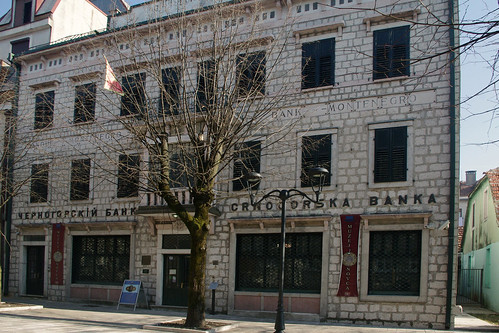
The Central Bank of Montenegro Money Museum
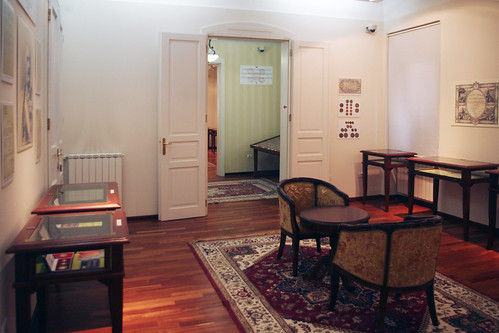
A view of one of the galleries that house 41 display cases.
The Museum’s exhibits occupy the first two floors of the building. The second floor has 41 cases with more than 1,000 coins and banknotes on display in the theme “From Perper to Euro.” As its title suggests, there are many changes in the money’s denominations. These include coins from the Austro-Hungarian Empire (1851-1906), and importantly a virtually complete collection of the coins and banknotes used in Montenegro from the perper (1906-1916) to the end of the dinar (2003), when it was replaced by Deutsche mark as its legal tender. In between, coins and banknotes are from the Montenegrin Kingdom, Kingdom of Serbs, Croats, and Slovenes, Kingdom of Yugoslavia, the German Occupation (1941-1945), Independent State of Croatia (1941-1945), Yugoslavia (1945-2003), Union of Serbia and Montenegro (2003-2006).
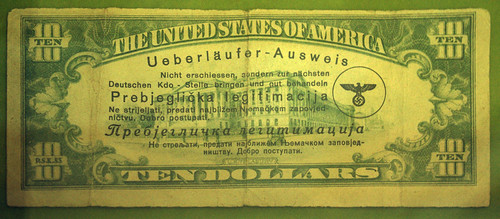
On display is a $10 note with a Nazi overprint. Functioning as a “Deserter Pass,” the legend in German, Serbian and Croatian, essentially says: "Don't shoot, take this man to the nearest German Command Post and treat him well".
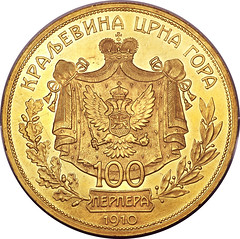 One highlight of the
exhibition are two examples of the 1851 gold perun (2 talers), the coin and currency prince-bishop Petar II Petrovic-Njegoš intended to introduce. Also, there
are two series of the 1910 10, 20, and 100 perpera coins – the only gold perper issues in the history of Montenegro. The inscription on the first set reads
“Principality of Montenegro” while the second set reads “Kingdom of Montenegro.” This is due to the fact that on 28 August 1910, Prince Nicholas of Montenegro
proclaimed the Kingdom of Montenegro as well as commemorating his 50th anniversary of reign. Virtually all of the information is given in both Montenegrin
(Latin and Cyrillic) and English.
One highlight of the
exhibition are two examples of the 1851 gold perun (2 talers), the coin and currency prince-bishop Petar II Petrovic-Njegoš intended to introduce. Also, there
are two series of the 1910 10, 20, and 100 perpera coins – the only gold perper issues in the history of Montenegro. The inscription on the first set reads
“Principality of Montenegro” while the second set reads “Kingdom of Montenegro.” This is due to the fact that on 28 August 1910, Prince Nicholas of Montenegro
proclaimed the Kingdom of Montenegro as well as commemorating his 50th anniversary of reign. Virtually all of the information is given in both Montenegrin
(Latin and Cyrillic) and English.
Although Montenegro is not yet a member of the European Union or its monetary union, it nevertheless uses the euro as its official currency.

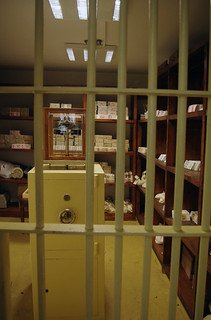
LEFT: The 1849 minting machine (that still runs),used for minting the first Montenegrin coins and still used for minting promotional coins.
RIGHT: The original vault of the 1906 Montenegrin Bank.
The ground floor of the museum has many examples of money incorporated as jewelry. These are necklaces, earrings, and head ornaments. Also on the ground floor is a working coin stamping press from 1849 and the original vault from the 1906 Montenegrin Bank.
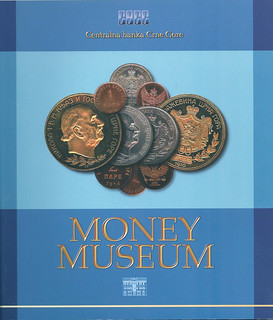
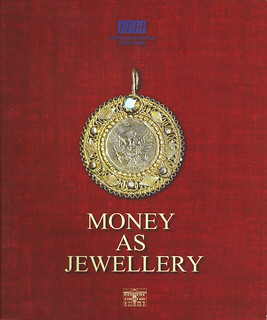
After presenting the Bank with a copy of my book, “The Numsmatourist,” Jovan reciprocated by giving me copies of two books produced by the Museum: Money Museum (2012, 152 pages, Radoje Žugić ed., ISBN 978-86-85815-12-6). Inquiries for those interesting in purchasing this book should be directed to Jovan Muhadinovic at jovan.muhadinovic@cbcg.me.
The other book, Money as Jewellery [sic] (2017, 42 pages, ISBN 978-86-85815-16-4) details the current exhibition. However, it is available as a free pdf download at: https://cbcg.me/en/currency/money-museum/publications with the link: https://cbcg.me/uploads/MONEY%20AS%20JEWELLERY%20Novembar%202017.pdf
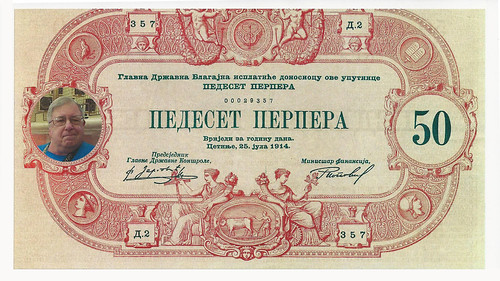
As if that wasn’t enough, the Museum provided me with a souvenir 1914 50 perper banknote with my picture as a vignette on the front. Visitors are able to purchase their own.
Thanks, Howard. Glad you're healthy again and back on the road. Cool souvenir note. And that's the first I've seen or heard of a "Deserter Pass" overprint on a U.S. banknote. -Editor

WAYNE'S NUMISMATIC DIARY: MARCH 17, 2019
Banknotes from Budapest
A nice surprise arrived in my mailbox Monday. It was a note from Dave Hirt, who had recently returned to Frederick, MD from a long stay in Budapest,
Hungary.
In an earleir E-Sylum article we discussed the new 500 forint Hungarian banknote. Dave wrote: "Balazs Csanady & I decided to send you one as a gift, but I found two with consecutive serial numbers. I am enclosing also a brochure explaining the security features."
Thanks! I scanned the notes and brochure.

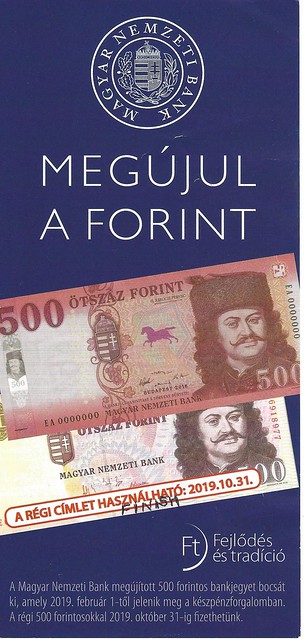
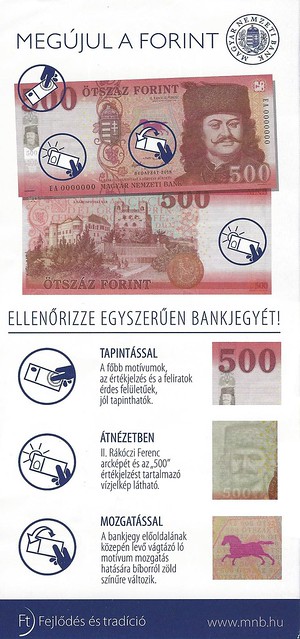
To read the earlier E-Sylum article, see:
HUNGARY COMPLETES BANKNOTE REDESIGN ROLLOUT
(https://www.coinbooks.org/v21/esylum_v21n51a21.html)
Nummis Nova March 2019


Tuesday, March 12, 2019 was the meeting night of my Northern Virginia numismatic social group Nummis Nova. Tom Kays was our host - we met at Osteria Marzano, a restaurant in an office complex near Alexandria, VA.
I was among the last to arrive. The waiter kindly took a group photo with Tom's phone. Clockwise from front left are Steve Bishop, Eric Schena, Dave Schenkman, Robert Hoppensteadt, Chris Neuzil, Tom Kays (standing), Jon Radel, Joe Esposito and me, Wayne Homren. In the second photo Chris Neuzil examines a Finnish art medal.
Pittsburgh-Butler Turnpike Note

Dave Schenkman brought along this new acquisition, which for me was my favorite exhibit of the evening. I collected Pittsburgh obsolete banknotes for many years, and never encountered this one. It's rare and historically important. Notice that it's serial number 1, which is perhaps why it was saved from destruction over the years. I used to regularly travel the main road leading from Pittsburgh to the city of Butler, PA (now State Rt. 8).
Dave's article on turnpike notes and tokens will be in The Numismatist soon.
Kilenyi Alcoa Aluminum Wright Brothers Anniversary Medal
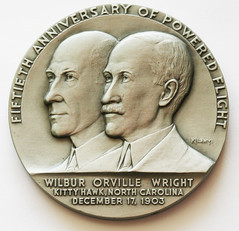
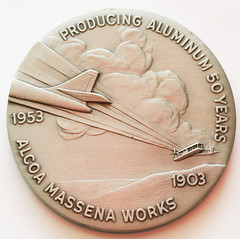
Dave also brought along this nice aluminum Julio Kilenyi medal commemorating the 50th anniversary of the Wright Brothers' historic flight at Kitty Hawk. great medal - I like it.
1902 Scovill Medal
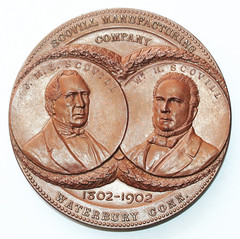
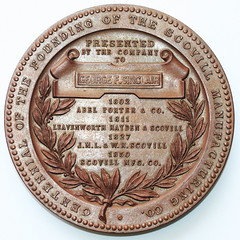
But wait, there's more! Here's another Schenkman exhibit item, a 76mm bronze 1902 Scovill medal.
Another Author! The Shelter
I learned we have another author in our ranks. in addition to everyone's numismatic books and Joe Esposito's recent nonfiction book Dinner in
Camelot, Robert Hoppensteadt is about to publish a fiction novel. The book is still in production, but he was able to share the cover art. Here's
Solstice Publishing's jacket blurb:
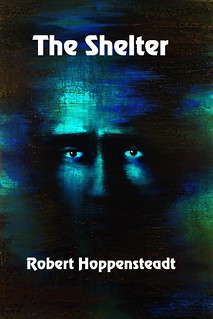 "In the half-light of an Alaskan
summer night Matt Tulugak pulls his truck off a gravel road and gets out to relieve himself. Looking out over the tundra, he sees a brown gash where permafrost
has melted and sloughed off a low hillock. A bony claw reaches out of the mud. He shivers in the light breeze, notices the crescent moon hanging low in the
sky, starts to walk. As he approaches the claw it resolves into five huge mammoth tusks arranged in a circle. Within the circle a human skull, half buried and
yellow with age, looks through empty eye sockets into a world that is about to change forever."
"In the half-light of an Alaskan
summer night Matt Tulugak pulls his truck off a gravel road and gets out to relieve himself. Looking out over the tundra, he sees a brown gash where permafrost
has melted and sloughed off a low hillock. A bony claw reaches out of the mud. He shivers in the light breeze, notices the crescent moon hanging low in the
sky, starts to walk. As he approaches the claw it resolves into five huge mammoth tusks arranged in a circle. Within the circle a human skull, half buried and
yellow with age, looks through empty eye sockets into a world that is about to change forever."
An Afghanistan Multiple Dirham
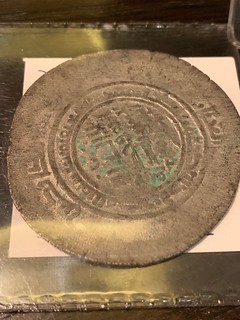
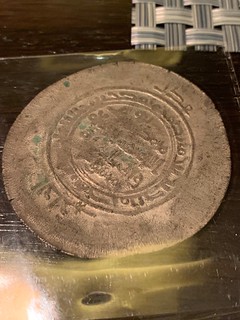
Eric Schena brought along this Afghanistan Multiple Dirham from the Ghaznavid dynasty. Photos courtesy Tom Kays.
A Token Tale
Dave Schenkman brought along a donation for our local young numismatist program, but I told him I'd pass it along to the American Numismatic Association YN
auction. It's got an interesting story a young researcher might wish to follow up on for an article. Below are my poor cellphone photos.
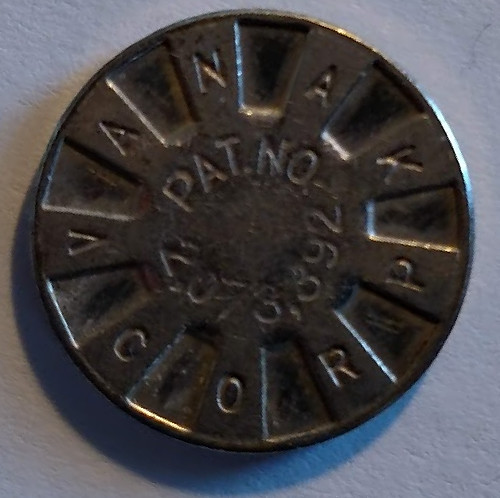
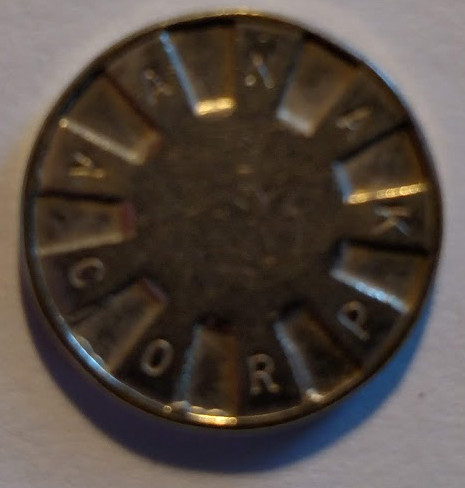
It's a token Bill Fivaz bought in a small collection and sent along to Dave. He wrote, "... have no idea what VANAK CORP" is - have you seen this rascal before? Keep the thing if you think if it's worth less than $1,000."
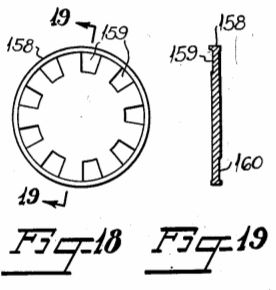 Well, it's worth considerably less - it's a common piece cataloged in the Amusement
Token book, Video Arcade, Pinball, Slot Machine, and other Amusement tokens of North America, by Stephen P. Alpert and Kenneth E. Smith. Steve Bishop
noted the patent number and later sent me the complete text of the patent for an "Adjustable Check Testing Apparatus" filed July 20, 1935 by Aaron A.
Knee (and patented March 9, 1937 as #2,703,392).
Well, it's worth considerably less - it's a common piece cataloged in the Amusement
Token book, Video Arcade, Pinball, Slot Machine, and other Amusement tokens of North America, by Stephen P. Alpert and Kenneth E. Smith. Steve Bishop
noted the patent number and later sent me the complete text of the patent for an "Adjustable Check Testing Apparatus" filed July 20, 1935 by Aaron A.
Knee (and patented March 9, 1937 as #2,703,392).
"Figure 18 is an elevation of a special slug or coin which is slightly larger in diameter than a normal coin and which is adapted to be used in connection with the structure shown in firurge 15, 16 and 17;"
Toned Dollars
Steve Bishop brought four nicely toned Morgan dollars. They don't all come off well in the photos, but looked great in person.
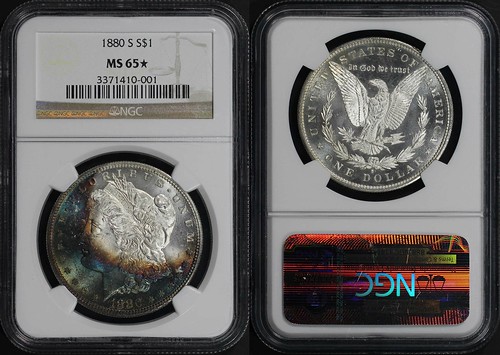
1880-S Morgan Dollar

1881-S Morgan Dollar
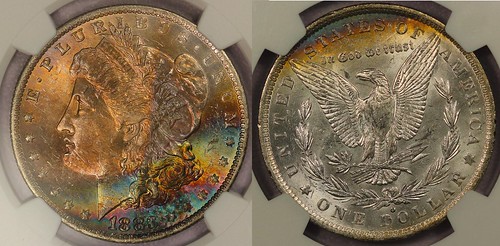
1883-O Morgan Dollar

1884-CC Morgan Dollar
Art Medals
Jon Radel can always be counted on for unusual material. Here are some new additions to his collection of Finnish art medals.
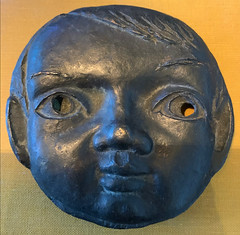
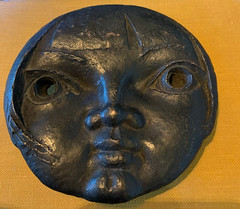
It was a smaller crowd than usual, but still a great night of excellent food, numismatic discussions and fellowship. But wait - there's more. Here's Tom Kays' report.
Tom Kays Tales from The Other Side of the Table
On Tuesday, Nummis Nova met at Osteria Marzano, an upscale Italian Restaurant just off the Fairfax County Parkway. I was our host and we all welcomed meeting
in the daylight for the first time since Winter began. Nine of us supped including Wayne, Joe, Jon, Tom, Chris, Robert, Dave, Eric and Steve.
By now we are all on a first name basis, so I know, you know who’s who, without me naming names and drawing arrows. In the picture, see the special lighting we requested, all the better to see dark copper coins and old manuscripts at table in fine dining establishments that usually carry candlelight ambiance to extremes. No so in this case, as it appears Robert and Chris appear to be wearing planetary headgear, but that is just a joke from our waiter who knows how to take a group photo with panache.
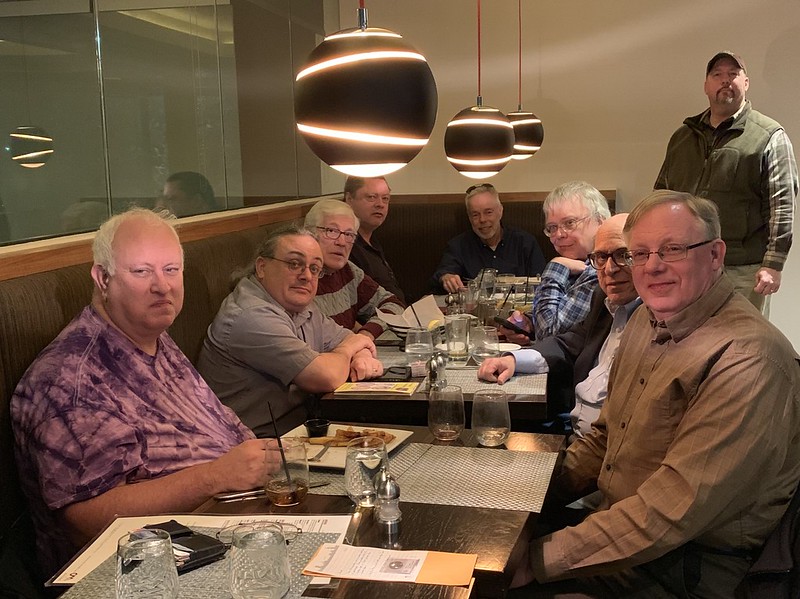
As related in prior E-Sylum editions, each month we face the awesome task of finding and bringing the finest numismatic objects and ephemera to wow this crowd, which is a difficult task after years of show-and-telling from our collections. It is not the monetary value that impresses, but we value historic or artistic expression and unique numismatic impact of collections and objects, sometimes needing little more than a fine presentation of most any old token or scrap of paper that we have not seen before.
This month I decided not to ‘sweat the load’ but simply brought whatever happened to be languishing in my collection, discovered to be in imminent danger from PVC flips. I pulled some items that had not seen the light of day for years from my “two-bit” collection of, well, two bits and pistareens. All have been rescued from their PVC hell with nice new archival flips.
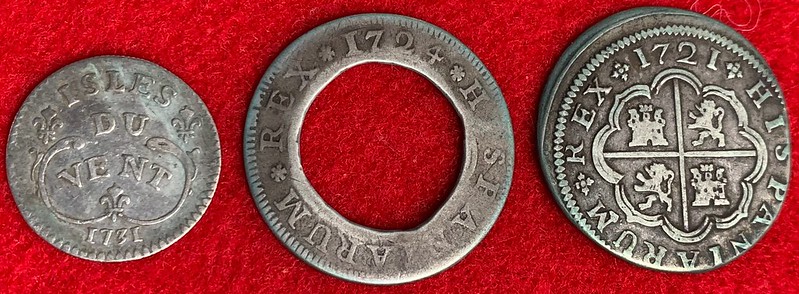
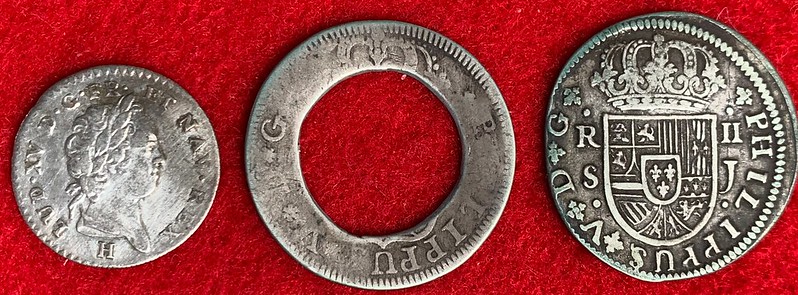
Wayne was impressed with one oddity, seen in the center of the image. “I paid extra for that hole,” is how I started to describe this silver, ‘two bitts’ that was punched on the Leeward Island of Dominica, circa 1816, and which started life as a 1724-dated, Spanish two reales of Philip V.
According to F. Pridmore in The Coins of the British Commonwealth of Nations, Part 3, West Indies this custom was a local practice to make coins that would stay and circulate on the Island, and not be shipped out as bullion due to their high metal value.
Next to it on the right is an example of the whole coin that did not suffer this fate. On the left is a contemporary French colonial Windward Islands coin for the “Isles Du Vent” in the Lesser Antilles, a 12-sols made under the authority of Louis XV at La Rochelle in 1731, intended for Saint-Martin (the French side of the island) and points South, being the penultimate coin listed in the voluminous 18th Century Edition of the Standard Catalog of World Coins by Chester L. Krause and Cliff Mishler.
As I said, this was just whatever happened to be in hand the day of our dinner. More examples of two bits from odd colonial mints were present in my mahogany display case, but mine was not the only item floating by under those planetary lights.
Also seen were a dollar from the Pittsburgh and Butler Turnpike Road Company of January 1st , 1822, an aluminum medal for the Fiftieth Anniversary of Powered Flight featuring Wilbur and Orville Wright on the obverse, and the ALCOA Massena Works – Producing Aluminum for 50 Years reverse, a Scovill Manufacturing Company Centennial Medal from 1902, presented to George F. Sinclair, a massive Finnish Medal seemingly in iron, with eye sockets holes that connect the pupils of a boys sculptural face and a girls sculptural face on opposite sides, a series of attractively toned Morgan dollars in high MS grades, several interesting and large, Multiple Dirham silver coins from Afghanistan dating to the Ghaznavid Dynasty (quick off the top of your head how old would they be) and a 1965, 2nd Edition of Coins and Collectors by Q. David Bowers that shows an advertisement offering up to three of the 1933 Double Eagles for sale.
Show and Tells had to make way for fine dining including my Yellow Fin Tuna grilled to perfection topped off with a Sicilian Limon Glace to make for a perfect evening of conviviality.
1889 PENNY SAVED WWI SOLDIER'S LIFE
Scott Miller passed along this interesting BBC News article about a coin that saved a soldier's life. Thanks. The coin and the soldier's British War Medal and Victory Medal. will be sold on March 22, 2019. -Editor

Pte John Trickett would have been shot in the heart if not for the coin he kept in his breast pocket.
Instead, the bullet ricocheted up his nose and out through the back of his ear, leaving him deaf in his left ear.
The dented 1889 penny is due to be sold by Hansons Auctioneers as part of a collection of war-related items belonging to the soldier.
His granddaughter, Maureen Coulson, from Duffield, Derbyshire, said: "Everyone in our family saw the penny and heard the story of how it saved my grandfather's life.
The 63-year-old said her grandfather, who was about 19 when he was shot in 1918, was "a great big guy from a Lincolnshire farming background but as soft as a brush".
After he was shot, he was discharged and went on to marry Mrs Coulson's grandmother and they had eight children.
Mrs Coulson added: "It's strange to think that, but for that penny, his children would not have been born and I wouldn't be here."
Adrian Stevenson, a militaria expert from Hansons, said: "It looks to me like a pistol bullet hit the penny at close range.
"It left him deaf and disabled but still alive.
"I've come across many stories of random objects saving soldiers' lives but I've never seen anything like this before."
To read the complete article, see:
Pocket penny that saved soldier's life to be sold
(https://www.bbc.com/news/uk-england-derbyshire-47575493)
APOLLO 11 HALF DOLLARS GO TO SPACE
Coin World reported that two Apollo 11 half dollars have been sent on a trip to space. -Editor
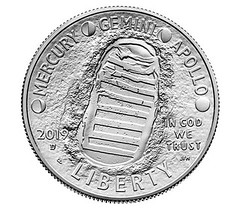 Mint Director
David J. Ryder lived up to a promise he made Dec. 13 during a first strike ceremony at the Philadelphia Mint for the Apollo 11 50th Anniversary commemorative
coin program — to actually put examples of the coins into space.
Mint Director
David J. Ryder lived up to a promise he made Dec. 13 during a first strike ceremony at the Philadelphia Mint for the Apollo 11 50th Anniversary commemorative
coin program — to actually put examples of the coins into space.
Two Proof 2019-S Apollo 11 50th Anniversary copper-nickel clad half dollars were launched into space at 3:14 p.m. Eastern Time on Pi Day, March 14, as part of the payload aboard the Soyuz MS-12 rocket from the Baikonur Cosmodrome in Kazakhstan to the International Space Station.
I always wanted to find a way to work "Baikonur Cosmodrome" into The E-Sylum. Earlier this week my son Chris and I saw the documentary film Apollo 11, and I'd recommend it, especially for the younger generation born long after the event. The Hollywood-quality color film documents every aspect of the mission in an understated, low-key matter-of-fact manner that only a government agency can provide. Yet the scale and scope of the endevour are breathtaking, underscoring an accomplishment that could only be undertaken with the resources and backing of a nation-state. At the age of 10 I was unimpressed by what I saw on our little black and white television. This footage is amazing.
When the coins return from their trip they will be displayed in Washington, D.C. at the Smithsonian Institution’s Air and Space Museum and the U.S. Mint headquarters. -Editor
To read the complete article, see:
NASA sends two Proof 2019-S Apollo 11
50th Anniversary half dollars into space (https://www.coinworld.com/news/us-coins/2019/03/apollo-11-coins-head-to-international-space-station.all.html)

THE 2019 MEXICAN LIBERTAD SERIES
Lou Golino published a piece on the 2019 Mexican Libertad series on Coin Update March 12, 2019. See the complete article online. -Editor
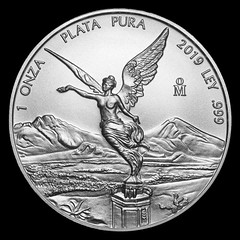 As seasoned
collectors of the popular Mexican series are well-aware, each year’s Libertad coin program results in some surprises and unexpected developments. Last year it
was the introduction of a new variety, the Antique silver Uncirculated coins issued in one, two, and five-ounce formats, and the release of the first-ever gold
Reverse Proof coins in half and one-ounce sizes.
As seasoned
collectors of the popular Mexican series are well-aware, each year’s Libertad coin program results in some surprises and unexpected developments. Last year it
was the introduction of a new variety, the Antique silver Uncirculated coins issued in one, two, and five-ounce formats, and the release of the first-ever gold
Reverse Proof coins in half and one-ounce sizes.
For 2019, there have already been two surprises, and more could be in store later in the year. First, the silver Uncirculated and Proof coins are being released earlier than usual. The Uncirculated pieces hit the market in February rather than late spring as is more typical, and the Proof coins have been struck and will reach dealers in March. Both versions in silver are issued from 1/20th-ounce coins through one-kilo coins. The kilo pieces are also expected to be released soon.
To read the complete article, see:
Libertad coin series: 2019 program’s surprises may have
only begun (http://news.coinupdate.com/libertad-coin-series-2019-programs-surprises-may-have-only-begun/)
50TH JEWISH-AMERICAN HALL OF FAME MEDAL ISSUED
A hefty double press release arrived this week on two important and related events - the 50th medal issued in the Jewish-American Hall of Fame series, and an exhibit celebrating the 50th anniversary at the Skirball Museum in Cincinnati. Congratulations to Mel Wacks on these important milestones. Here's the information on the 50th medal. -Editor

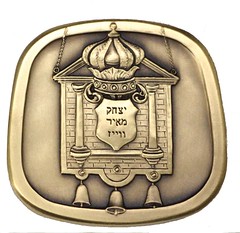
Rabbi Isaac Mayer Wise Medal by Eugene Daub is 50th in the Jewish-American Hall of Fame Series
The Jewish-American Hall of Fame series of medals was launched 50 years ago under the direction of Mel Wacks, who continues to guide what is now the longest continuing series of art medals in the United States, and perhaps the world. These medals have been created by renowned medalists, such as Eugene Daub, designer of a dozen issues including the latest, honoring Rabbi Isaac Mayer Wise (1819-1900).
The 2-inch diameter Isaac Mayer Wise art medals are limited to no more than 150 bronze, 75 pure silver (3 oz.) and 35 gold-plated pure silver (3 oz.) medals, offered for contributions of $50, $200 and $250 respectively to the non-profit Jewish-American Hall of Fame. To order, call 818-225-1348 or send payment to JAHF, c/o Mel Wacks, 5189 Jeffdale Ave., Woodland Hills, CA 91364. Mention that you read about it in The E-Sylum and you can take a 20% discount. Each medal is numbered on the edge, and comes with a certificate of authenticity.
The high relief portrait of Wise was based on a plaque made by Boris Schatz; the Torah Breastplate depicted on the reverse was crafted by Andrew Messmer, and presented to Rabbi Wise on his 80th birthday. The plaque and breastplate are both in the collection of the Skirball Museum, Cincinnati. The medals were struck by The Highland Mint.
Isaac Mayer Weiss was born on March 29, 1819, the oldest son of Regina and Leo Weiss, in Steingrub, Bohemia (currently a part of the Czech Republic). He was a brilliant student, and at the age of nine, his father, a teacher, had taught him all he knew about the Bible and the Talmud. He then went to study with his grandfather, a physician, who died three years later. Weiss continued his studies in the Talmud and the Bible at various schools. He completed his formal education by attending the University of Prague and the University of Vienna for three years.
At the age of 23, in 1842, he appeared before a Beth Din - or a rabbinical court - of three well-known rabbis: Solomon Judah Rappaport, Samuel Freund, and Ephraim Loeb Teweles, who together conferred on him the title of rabbi. Two years later, he married Therese Bloch, who gave birth to ten children by him.
Weiss found that being a rabbi in Bohemia brought him problems with the government, because of the restrictions still in force against the Jews. He decided to come to America because of its religious freedom, arriving in New York on July 23, 1846 (and changed the spelling of his name to Wise).
Wise became the rabbi of Congregation Beth El in Albany, N.Y. He was there four years, initiating new reforms in the religious services. He introduced choral singing, confirmation to replace Bar Mitzvah, and the seating of men and women together in pews for services.
His changes resulted in much disapproval. In 1850, on the morning of the beginning of Rosh Hashanah that evening, Wise was dismissed at a rump meeting of the board of directors. The next day havoc broke loose between his followers and those who opposed him. Soon after, a group broke away from Beth El and, with Rabbi Wise, established a new Reform synagogue called Anshe Emet - "Men of Truth."
In 1854, Wise went to Cincinnati, Ohio, to become rabbi of Beth K.K. B'nai Yeshurun, a Reform congregation. (Since 1931, the temple has been known as the Isaac M. Wise Temple.) He stayed there the rest of his life. it was from there that he tried creating a national organ-ization of congregations. He found this a difficult task, as the Orthodox rabbis were at odds with the Reform movement. Nevertheless, despite his setbacks, Wise continued to advocate a union of congregations, a common prayer book, and a college to educate and train American rabbis.
Parts of his dreams came true when, in 1873, when delegates from 34 Reform congregations met in Cincinnati and organized the Union of American Hebrew Congregations. Two years later, in July 1875, the Union established the Hebrew Union College, the first Jewish seminary in the United States. Wise became its president and teacher.
Wise was also an organizer and mover in the establishment of the Central Conference of American Rabbis, in 1889. Elected its president, he served until he died. This conference adopted the Union Prayer Book that would be used by all Reform congregations. Rabbi Isaac Mayer Wise died on March 26, 1900.
Further information about the Jewish-American Hall of Fame medals can be found at www.amuseum.org/jahf .
JEWISH-AMERICAN HALL OF FAME MEDAL EXHIBIT
Here is information on the exhibit celebrating the 50th anniversary of the Jewish-American Hall of Fame medal series. -Editor
Striking Medals: 50 Years of the Jewish-American Hall of Fame on Exhibit at the Skirball Museum in Cincinnati
 One of the largest
exhibits of medals in recent years will be on display from March 21 through June 2, 2019 at the Skirball Museum on the historic Cincinnati campus of Hebrew
Union College–Jewish Institute of Religion. The Skirball Museum was the first formally established Jewish museum in the United States, founded in 1913 as the
Union Museum. The exhibit, titled “Striking Medals: 50 Years of the Jewish-American Hall of Fame,” will mark the first time that a complete collection of this
historic series has ever been on public display, according to JAHF founder Mel Wacks.
One of the largest
exhibits of medals in recent years will be on display from March 21 through June 2, 2019 at the Skirball Museum on the historic Cincinnati campus of Hebrew
Union College–Jewish Institute of Religion. The Skirball Museum was the first formally established Jewish museum in the United States, founded in 1913 as the
Union Museum. The exhibit, titled “Striking Medals: 50 Years of the Jewish-American Hall of Fame,” will mark the first time that a complete collection of this
historic series has ever been on public display, according to JAHF founder Mel Wacks.
In addition to showing two sides of each medal issued annually from 1969 through 2019, The exhibition features all 50 medals, produced annually from 1969 through 2019 in duplicate, so that the reverse of each can be viewed, as well as displays that chronicle the history and origin of portrait medals; the process of creating the medals from original sketches to clay and plaster models and dies; and texts and videos about the accomplishments of the inductees.
Visitors will learn about the Spanish Jews who helped finance the voyage of Christopher Columbus, and how Asser Levy fought for and won the right for Jews to bear arms in the local militia of colonial New Amsterdam. Haym Salomon raised funds for the American Revolution but died penniless. Rebecca Gratz was a pioneer in education and Ernestine Rose fought for equal rights for women and the abolition of slavery. From leaders of nations like Golda Meir to leading entertainers like Barbra Streisand, Jews have made important contributions to the history and culture of America for hundreds of years in all fields of endeavor, and their stories are told in this exhibition. Also featured are several special commemorative medals marking significant anniversaries in the history of American Jewish life.
A number of educational programs will be held at the Museum, in conjunction with the exhibit. All programs are free and open to the public and are held on the campus of the Hebrew Union College, 3101 Clifton Avenue 45220. The exhibit is also free, and can be viewed Tuesdays and Thursdays: 11 AM – 4 PM, Sundays: 1 PM – 5 PM. For further information, reservations, or registration call 513.487.3098 or email jmendelson@huc.edu.
For more information on the Skirball Museum, see:
SKIRBALL MUSEUM IN CINCINNATI
(http://huc.edu/research/museums/skirball-museum-cincinnati)
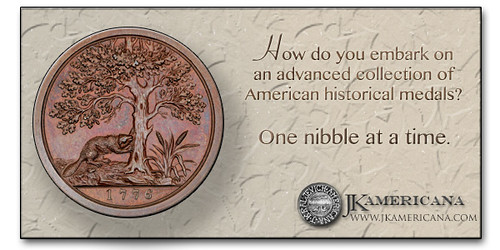
DEATH OF A NORTHERN IRISH BANKNOTE
Economist JP Koning recently blogged about the announcement by First Trust Bank of Northern Ireland that it would be discontinuing the issuance of its own banknotes. Here's an excerpt. I had seen the story but hadn't grasped its significance beyond numismatics. -Editor
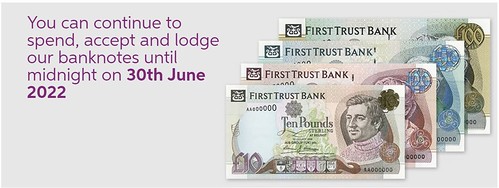
I was disappointed to see that First Trust Bank, a commercial bank based in Northern Ireland, will stop issuing its own brand of banknotes. Under different names, First Trust has been in the business of providing paper money for almost two hundred years, starting with the Provincial Bank of Ireland back in 1825.
99.9% of the world's population uses government-issued banknotes. A small sliver of us—those who live in Northern Island, Scotland, Hong Kong, and Macau—get to use privately-issued banknotes. Prior to First Trust's announcement, I count twelve private issuers scattered across the globe:
Northern Ireland: Bank of Ireland, Danske Bank (formerly Northern Bank), First Trust Bank, and Ulster Bank
Scotland: Bank of Scotland, Clydesdale Bank and The Royal Bank of Scotland
Hong Kong: HSBC, Standard Chartered, Bank of China (Hong Kong)
Macau: Banco Nacional Ultramarino, Bank of China (Macau)
Now there are just eleven.
To our modern sensibilities, privately-issued banknotes seem just strange. But before central banks emerged on the scene, privately-issued banknotes were the norm. Larry White and George Selgin have chronicled how the Scots were particularly adept at this task. Scotland's banking system, which was much more free than the British one, had relatively few bank failures in the 1700 and 1800s compared to the British one, which tried to put limits on banks' ability to issue notes.
In the 1800s this Scottish "free banking" system was imported into my country, Canada, by Scottish immigrants. People might assume that private banknotes were risky instruments, and that's why we needed governments to do the task. But as the chart below shows, between 1868 and 1910 Canadians experienced almost no losses on banknotes.
I'll stop my excerpt there, but see the complete article online for more on the history and importance of private banknotes, and the implications for a future without them. Thanks to JP for pointing out the significance of this event, and for the list of remaining private issuers. Great opportunity for a specialized collection and exhibit. -Editor
To read the complete articles, see:
Death of a Northern Irish banknote
(https://jpkoning.blogspot.com/2019/02/death-of-northern-irish-banknote.html)
First Trust Bank to cease issuing its own banknotes (https://firsttrustbank.co.uk/banknotes)
HOW COLONIAL MASSACHUSETTS CREATED MONEY
Stephen Mihm is a history professor and author of A Nation of Counterfeiters. His March 15, 2019 article on Bloomberg offers an interesting and compelling explanation of the creation of money using colonial Massachusetts paper money as an example. -Editor
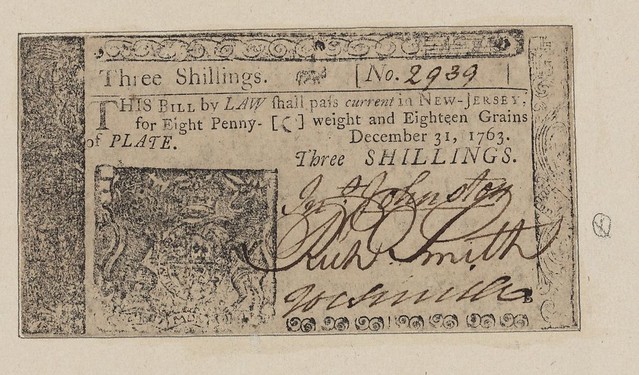
Massachusetts inspired a burst of colonial currencies, including a 3-shilling note issued by New Jersey in 1763.
Hell hath no fury like an economist provoked by Modern Monetary Theory. Paul Krugman, Ken Rogoff, Larry Summers, and many others have attacked MMT, calling it “fallacious,” “nonsense,” and for good measure, “wrong.” Federal Reserve Chairman Jerome Powell has slammed “the idea that deficits don’t matter for countries that can borrow in their own currency” as “just wrong.”
The MMT debate is endlessly complex and increasingly hysterical. But it does not represent an entirely new chapter in U.S. history. Several centuries ago, a handful of creative colonists in Massachusetts came up with a desperate but undeniably ingenious solution to their monetary woes that anticipated one of the key tenets of MMT. It worked — up to a point.
Much of the acrimonious debate over MMT boils down to a difference of opinion over the origins and nature of money. (There are other differences, like diametrically opposed views of the relationship between deficits and interest rates.) For most economists, money begins as a way of solving the problems of barter. It offers an intermediary between economic actors, enabling them to buy and sell without exchanging, say, a goat for several bushels of grain.
But in order for money to play this role, it has to maintain the confidence of those who use it and hold it. For that reason, conventional thinking once went, only something that has intrinsic value — gold and silver, most obviously — could play this role.
Yet over the course of the 20th century, nation after nation abandoned the gold standard. From this point forward, the value of money would depend not on precious metals, but the prudence of central bankers. The enforced scarcity of money would be what gave it value.
MMT dispenses with these concepts and their many variants. Rather than viewing money as something natural and rare or the product of independent central bankers, MMT argues that modern fiat currency is purely a creature of the state, and derives its value from the fact that it can be used to pay taxes.
Put differently, MMT holds that when it comes to government spending, the usual equation — governments collect money via taxes and then spend it on government programs — is backwards. MMT proponents claim the actual mechanics of money creation goes like this: The government spends, creating money in the process. This money goes into the economy, and is then removed via taxation.
This can seem a bit counterintuitive, which is why it’s helpful to go back in time to 1690s Massachusetts. Over the course of the seventeenth century, dissenting Puritans founded and developed the colony of Massachusetts into a thriving commercial hub. As the population and economy boomed, they faced a growing problem: a lack of money.
They had plenty of illiquid assets: land, agricultural produce, and other things. But for several complicated reasons, including trade imbalances, the colonists lacked a medium of exchange. Coins were extraordinarily scarce, posing an obstacle to economic growth.
The Puritans tried to solve the problem in different ways, like setting up a private mint and establishing private “land banks” (which used land titles as collateral for the issuance of paper notes). In each case, though, imperial officials quashed or thwarted these plans.
In 1689, Massachusetts did its part in the endless imperial wars of the era, sending soldiers on an abortive mission to capture part of French Canada. The soldiers returned, suffering from smallpox, and they understandably demanded payment for their services.
But there was a serious problem: The colonial government had no money, and failed to secure a loan. It fell to a small committee of prominent citizens to figure out what to do. The head of the committee was a man named Elisha Hutchinson.
Hutchinson and the others devised an unusual solution to the problem. They issued what is generally recognized as the first fiat currency in the Western world. The twenty-shilling notes they printed cheekily claimed that they “shall be in value equal to money” — meaning that they were equivalent to silver coin.
This was, on the face of it, preposterous. Massachusetts had no ability within its borders or beyond to compel people to accept the money at face value. Despite its promise to redeem the money at a “convenient time,” the colonial treasury could not do so when it first issued the bills.
Dror Goldberg, the leading historian of this formative episode, summed up this venture: “Never before has history seen such a weak money.” Which begs the obvious question: Why would any self-respecting soldier accept it, or for that matter, a shopkeeper, merchant, or anyone else?
The answer lies with the other language that appeared on the bill. It declared that they “shall be accordingly accepted by the Treasurer, and receivers subordinate to him, in all public payments.” They could be used to pay taxes.
Hutchinson and his allies spent before they taxed. And it was precisely that fact — that the money they injected into the economy would then be withdrawn via taxation — that gave the money its value. And it worked. The money circulated in the colony, greasing the wheels of commerce, and then disappearing at tax time.
They didn’t realize it at the time, but this group of dour Puritans had effectively invented a crude forerunner of MMT, though they would have probably called it PMT (Puritan Monetary Theory). A government spent before it taxed, creating money in the process; this money fueled economic activity; and then taxation sucked the money out of the economy.
It was a brilliant invention, and as Goldberg notes, “The currency we use today is essentially the same as the money created in Massachusetts.”
To read the complete article, see:
American Colonists Had a Modern
Monetary Theory of Their Own (https://www.bloomberg.com/opinion/articles/2019-03-15/american-colonists-had-a-modern-monetary-theory-of-their-own)
ALTERNATE CURRENCY TOTNES POUND DISCONTINUED
Governments today can create all the money they want virtually without ever firing up a physical printing press. As the economy as a whole goes evermore cashless, even local alternative currencies are threatened. Here's a BBC News story found via the March 12, 2019 News & Notes newsletter from the Society of Paper Money Collectors about the demise of the Totnes Pound from Devon, England. -Editor
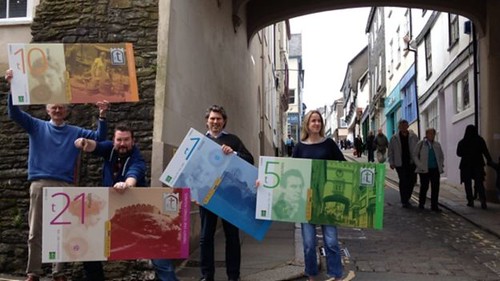
A town which started printing its own money more than a decade ago has ended the project blaming the "cashless economy" for its decline.
Totnes pounds were introduced in March 2007 as part of a month-long experiment to encourage local spending in the Devon town.
Organisers Transition Town Totnes said "an increasingly cashless economy" had contributed to the currency's decline.
Shoppers will be able to spend or redeem the pounds up until 30 June.
John Elford, of the Totnes Pound Steering Group, said: "Over time we have seen a decline in the use of the Totnes Pound, partly due to an increasingly cashless economy.
"However, if we measure the project's success in terms of the degree to which it provoked reflection on the importance of the local economy, then we have to say the Totnes Pound has been a real success."
The scheme saw more than 30,000 Totnes pounds circulated among local businesses over the years.
What might seem like criminal activity was actually perfectly legal, with the notes being copies of a local pound note last in circulation in 1810.
To read the complete article, see:
Totnes pound: Currency killed by 'cashless economy'
(https://www.bbc.com/news/uk-england-devon-47471231)
PHILADELPHIA BANS CASHLESS STORES
I didn't manage to fit this one into an earlier issue, but here's a March 7, 2019 Wall Street Journal story about one city's backlash against the cashless onslaught. -Editor
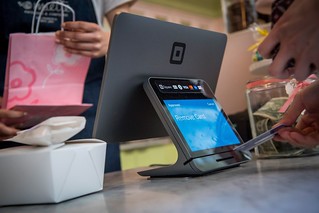 Philadelphia is the
first major U.S. city to ban cashless stores, placing it at the forefront of a debate that pits retail innovation against lawmakers trying to protect all
citizens’ access to the marketplace.
Philadelphia is the
first major U.S. city to ban cashless stores, placing it at the forefront of a debate that pits retail innovation against lawmakers trying to protect all
citizens’ access to the marketplace.
Starting in July, Philadelphia’s new law will require most retail stores to accept cash. A New York City councilman is pushing similar legislation there, and New Jersey’s legislature recently passed a bill banning cashless stores statewide. A spokesman for New Jersey Gov. Phil Murphy, a Democrat, declined to comment on whether he would sign it. Massachusetts has gone the farthest on the issue and is the only state that requires retailers to accept cash.
The measures seek to blunt a nascent trend that could rapidly accelerate thanks to Amazon.com Inc.’s power to shape nationwide retail trends. They represent an attempt to strike a balance between equity for lower-income consumers and merchants’ eagerness to embrace technological advances.
Businesses that have gone cashless point to greater efficiency for employees, who don’t have to make change or count cash at closing time, and improved safety because workers don’t have to carry large bank deposits.
But backers of measures forcing stores to accept cash say they worry about people who don’t have credit or debit cards. Supporters also say some consumers prefer to pay with currency for privacy reasons.
To read the complete article (subscription required), see:
Philadelphia Is First U.S. City to Ban Cashless
Store (https://www.wsj.com/articles/philadelphia-is-first-u-s-city-to-ban-cashless-stores-11551967201)
NEW JERSEY’S SAINT PATRICK COPPERS
Brandon Christopher Hall of Coin Update published a nice piece on Saint Patrick coppers March 14, 2019. We're republishing it here with permission. Happy St. Patrick's Day! -Editor
In preparation for the upcoming 73rd edition of the Guide Book of United States Coins, which is expected to draw increased attention to foreign coins that were used in Colonial America, I thumbed through the Colonial Issues section of the 4th edition of Mega Red and came across something both interesting and festive. If you are one of the millions of Americans that love to celebrate Saint Patrick’s Day (which is coming up this Sunday), then it might be interesting to know that there really are numismatic treasures out there associated with the holiday: Saint Patrick coppers. These coins are beautiful examples of foreign issues that were circulated in Colonial America and the reverse designs depict the eponymous Saint Patrick himself. Saint Patrick coppers also trace their origin to Ireland. According to Mega Red:
Mark Newby was a shopkeeper in Dublin, Ireland, in the 1670s and came to America in November 1681, settling in West Jersey (today’s New Jersey). He brought with him a quantity of copper pieces, of two sizes, believed by numismatists to have been struck in Dublin circa 1663 to 1672. These are known as St. Patrick coppers. (Alternatively, they may have been struck for circulation in Ireland by Pierre Blondeau to fill an order made by the duke of Ormonde, but this has not been confirmed.) The larger-sized piece, called by collectors a halfpenny, bears the arms of the City of Dublin on the shield on the reverse. The smaller-sized piece, called a farthing, does not. Although neither bears a denomination, these are designations traditionally assigned by numismatists. Both sizes have reeded edges.
Newby became a member of the legislature of West Jersey, and under his influence the St. Patrick coinage was made legal tender by the General Assembly of New Jersey in May 1682. The legislature did not specify which size piece could circulate, only that the coin was to be worth a halfpenny in trade and that no one would be obliged to accept more than five shillings’ worth (120 coins) in one payment. Some numismatists believe the larger-size coin was intended. However, many more farthing-size pieces are known than halfpennies, and numerous coins of the farthing size have been excavated by detectorists in New Jersey, while none of the larger coins have been found this way. Most numismatists believe that the smaller-sized piece was the one authorized as legal tender. Copper coins often circulated in the colonies at twice what they would have been worth in England.
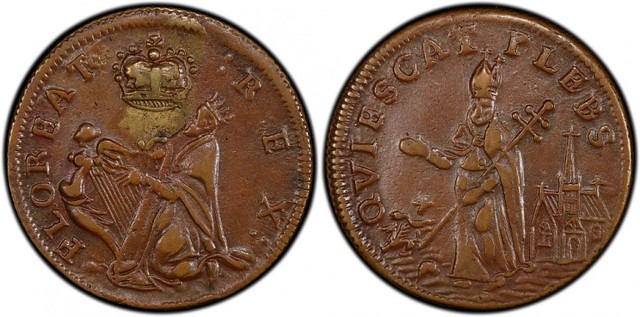
St. Patrick farthing New Jersey, BN (Regular Strike).
The reverse of the farthing depicts Saint Patrick holding a metropolitan cross in his left hand while driving away serpents. The inscription reads QUIESCAT PLEBS (“May the People Be at Ease”).

St. Patrick halfpenny New Jersey, BN (Regular Strike).
On the contrary, the reverse of the halfpenny depicts Saint Patrick in a different light: He holds a trefoil in his right hand and a crozier in his left while being surrounded by a group of people. The inscription of the halfpenny reverse reads ECCE GREX (“Behold the Flock”).
Which coin (or both) do you think was intended to be the true representation of Saint Patrick in the American colonies? Let us know in the comments, and have a Happy Saint Patrick’s Day!
To read the complete article, see:
Treasure at the end of the rainbow: New Jersey’s
Saint Patrick coppers (http://news.coinupdate.com/treasure-at-the-end-of-the-rainbow-new-jerseys-saint-patrick-coppers/)


